Paul van Yperen's Blog, page 232
June 9, 2019
Photo by Republic Pictures
Republic Pictures was an American film production-distribution corporation that operated from 1935 to 1967. The studio was best known for its Westerns, serials and B films emphasising mystery and action. Republic was also developed the careers of John Wayne, Gene Autry and Roy Rogers. It also financed and distributed several John Ford-directed films during the 1940s and early 1950s and one Shakespeare film, Macbeth (1948), directed by Orson Welles. Under the cigar-chomping Herbert J. Yates, Republic was considered a mini-major film studio.
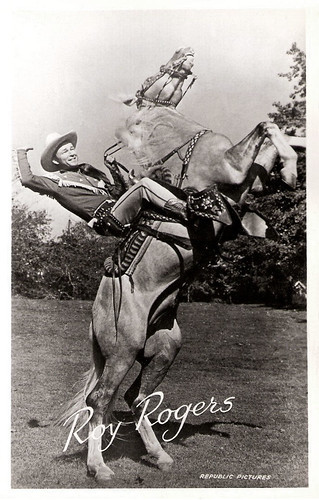
Dutch postcard. Photo: Republic Pictures.
American singer and cowboy actor Roy Rogers (1911–1998) was one of the most popular Western stars of his era. Known as the 'King of the Cowboys', he appeared in over 100 films.
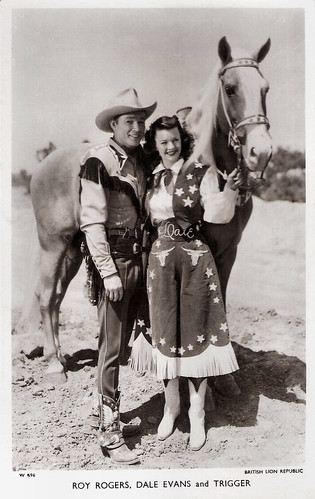
British postcard in the Picturegoer Series, London, no. W. 596. Photo: British Lion Republic. Roy Rogers, Dale Evans and Trigger.
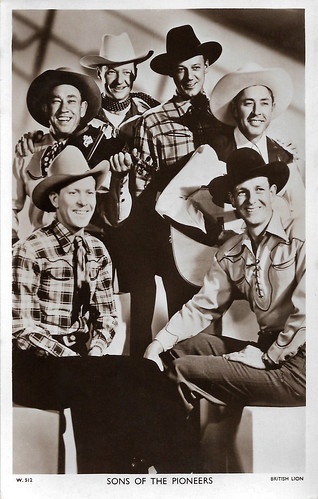
British postcard in the Picturegoer Series, London, no. W. 512. Photo: British Lion.
The Sons of the Pioneers are one of the United States' earliest Western singing groups. Known for their vocal performances, their musicianship, and their songwriting, they produced innovative recordings that have inspired many Western music performers and remained popular through the years. Since 1933, through many changes in membership, the Sons of the Pioneers have remained one of the longest-surviving country music vocal groups. Between 1935 and 1984, the Sons of the Pioneers appeared in 87 films.
A studio merger on Poverty Row
In 1935, Republic was created by Herbert J. Yates (1880-1966), a long time investor in film and owner of the film processing laboratory Consolidated Film Industries. Yates had discreetly helped finance Darryl F. Zanuck 's Twentieth Century Pictures in 1933. Zanuck's new studio would become a major customer of Yates' Consolidated Film Industries. Republic was initially formed by Yates' acquisition of six smaller independent studios along Gower Gulch, a section of Gower Street in Hollywood, also called 'Poverty Row'.
In the depths of the Great Depression, Yates' laboratory was no longer servicing the major studios, which had developed their own in-house laboratories for purposes of both economy and control, while the small, independent producers were going under in the face of Depression-born increased competition from the majors combined with the general impact of the depressed economy.
Yates thus decided to create a studio of his own to insure Consolidated's stability. Six surviving small companies (Monogram Pictures, Mascot Pictures, Liberty Pictures, Majestic Pictures, Chesterfield Pictures and Invincible Pictures) were all in debt to his lab. He prevailed upon these studios to merge under his leadership or else face foreclosure on their outstanding lab bills. Yates' new company, Republic Pictures Corporation, was presented to their producer-owners as a collaborative enterprise focused on low-budget product.
The largest of Republic's components was Monogram Pictures, run by producers Trem Carr and W. Ray Johnston, which specialised in B films and operated a nationwide distribution system. The most technologically advanced of the studios that now comprised Republic was Nat Levine's Mascot Pictures Corporation, which had been making serials almost exclusively since the mid-1920s and had a first-class production facility, the former Mack Sennett-Keystone lot in Studio City. Mascot also had just discovered Gene Autry and signed him to a contract as a singing cowboy star.
Larry Darmour's Majestic Pictures had developed an exhibitor following with big-name stars and rented sets giving his humble productions a polished look. Republic took its original Liberty Bell logo from M.H. Hoffman's Liberty Pictures as well as Hoffman's talents as a low-budget film producer. Chesterfield Pictures and Invincible Pictures, two sister companies under the same ownership, were skilled in producing low-budget melodramas and mysteries.
Acquiring and integrating these six companies enabled Republic to begin life with an experienced production staff, a company of veteran B-film supporting players and at least one very promising star, a complete distribution system and a functioning and modern studio. In exchange for merging, the principals were promised independence in their productions under the Republic aegis, and higher budgets with which to improve the quality of the films.
One of the first films Republic released successfully was the Western Westward Ho (Robert N. Bradbury, 1935) starring John Wayne and Sheila Bromley. Another box office hit was the Western Tumbling Tumbleweeds (Joseph Kane, 1935) starring Gene Autry, Smiley Burnette, and George ‘Gabby’ Hayes. Written by Ford Beebe, the film is about a cowboy who returns home after a five-year absence to find his father murdered and his boyhood pal accused of the dastardly deed. Tumbling Tumbleweeds features several songs including the classic 'Tumbling Tumbleweeds'.
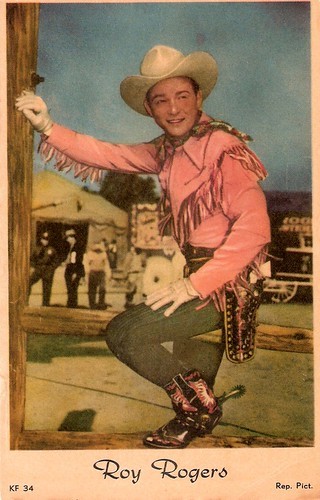
Dutch postcard, no. KF 34. Photo: Republic Pictures. Roy Rogers.
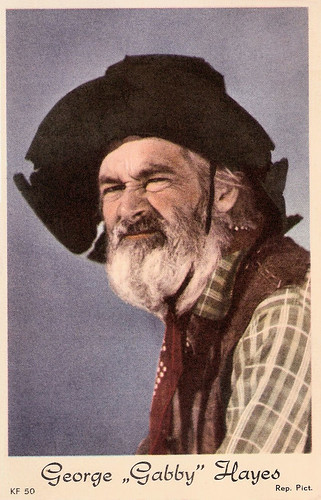
Dutch postcard, no. KF 50. Photo: Republic Pictures.
American character actor George 'Gabby' Hayes (1885-1969) was one of the colourful sidekicks to the leading men in the Hollywood Westerns of the 1930s and 1940s. His grizzled codger was so popular that Hayes landed repeatedly on the annual list of Top Ten Western Box-office Stars.
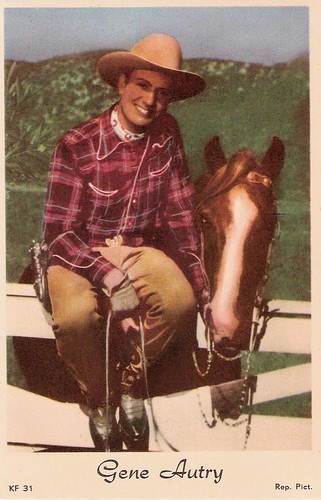
Dutch postcard, no. KF 31. Photo: Republic Pictures.
Gene Autry (1907-1998) was an American singer, and actor who gained fame as a singing cowboy in a crooning style on radio, in films, and on television for more than three decades beginning in the early 1930s. From 1934 to 1953, Autry appeared in 93 films, and between 1950 and 1956 hosted The Gene Autry Show television series.
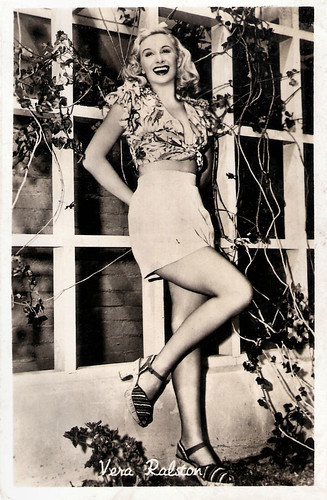
Belgian postcard by Nieuwe Merksemsche Chocolaterie S.P.R.L., Merksem (Anvers). Photo: Republic.
After achieving modest fame as an ice skater in her native Czechoslovakia, Vera Hruba (1923-2003) was brought to America by Republic Pictures head Herbert J. Yates, who hoped to turn her into the next Sonja Henie . After featuring her in two Ice Capades films, he added Ralston' to her name and tried to pass her off as a leading lady.
A Rise of Dissension in the Ranks
After he had learned the basics of film production and distribution from his partners, Herbert Yates began asserting more and more authority over their film departments, and dissension arose in the ranks. Trem Carr and W. Ray Johnston constantly clashed with Yates, who they felt was a tyrannical Hollywood interloper. They left and reactivated Monogram Pictures in 1937. Larry Darmour resumed independent production for Columbia Pictures.
Nat Levine managed to largely remain out of the fray, and by using many of the same production techniques he had used at Mascot, the new studio's output came to resemble the best of Levine's Mascot product. Levine was later bought out by Yates. Republic could also boast of having the best special effects department (then called 'miniatures') in the industry, which was headed by former Mascot employees Howard Lydecker and his brother Theodore Lydecker. This was a factor that greatly contributed to the quality level of Republic's output. Republic was often contracted by the major studios to provide special effects and miniature work for them.
Meanwhile, Yates installed a staff of new, associate producers who were loyal to him. Freed of partners, Yates presided over what was now his film studio and acquiring senior production and management staff who served him as employees, not experienced peers with independent ideas and agendas. Republic also acquired Brunswick Records to record its singing cowboys Gene Autry and Roy Rogers and hired Cy Feuer as head of its music department.
In its early years Republic was itself sometimes labelled a ‘Poverty Row’ company, as its primary products were B films and serials. Republic, however, showed more interest in — and provided larger budgets to — these films than many of the larger studios were doing, and certainly more than other independents were able to. The heart of the company was its Westerns, and its many Western-film leads — among them John Wayne, Gene Autry, Rex Allen and Roy Rogers — became recognisable stars at Republic.
However, by the mid-1940s Yates was producing better-quality pictures, mounting big-budget fare like Sands of Iwo Jima (Allan Dwan, 1949) starring John Wayne, The Quiet Man (John Ford, 1952) with John Wayne and Maureen O'Hara , Johnny Guitar (Nicholas Ray, 1954) with Joan Crawford and Sterling Hayden, and The Maverick Queen (Joseph Kane, 1956) featuring Barbara Stanwyck. Another distinguishing aspect of the studio was Yates' avoidance of any controversial subject matter, adhering to the Breen Office, in contrast to the other studios which dodged the Production Code.
From the mid-1940s Republic films often featured Vera Hruba Ralston, a former ice-skater from Czechoslovakia who had won the heart of studio boss Yates, becoming the second Mrs. Yates in 1949. She was originally featured in musicals as Republic's answer to Sonja Henie , but Yates tried to build her up as a dramatic star, casting her in leading roles opposite important male stars. Yates billed her as 'the most beautiful woman in films', but her charms were lost on the cinema audiences and exhibitors complained that Republic was making too many Ralston pictures. Years later, John Wayne admitted that the reason he left Republic in 1952 was the threat of having to make another picture with Miss Ralston. Yates remained Ralston's biggest supporter, and she continued to appear in Republic features until its very last production.
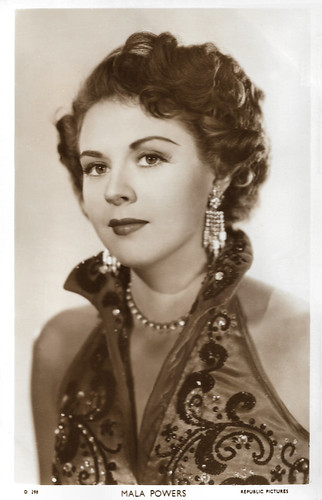
British postcard in the Picturegoer series, London, no. D 298. Photo: Republic Pictures.
American actress Mala Powers (1931-2007) played the lovely Roxanne opposite José Ferrer in Cyrano de Bergerac (1950) and starred in other Hollywood films of the 1950s. She was a leading authority on the acting techniques of Russian-American theatre practitioner Michael Chekhov.
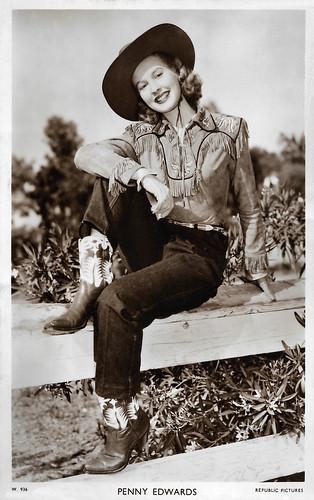
British postcard in the Picturegoer Series, London, no. W. 936. Photo: Republic Pictures.
Vivacious blue-eyed blonde Penny Edwards (1928-1998) was an American actress who performed on stage, in films, and on television. She made about two dozen films, initially working at Warners and Universal in the 1940s. She was under a term players contract at Republic Pictures from May, 1950 through October, 1951. At Republic, Edwards did mostly Westerns - six with Roy Rogers and one each with Rex Allen and Allan Lane.
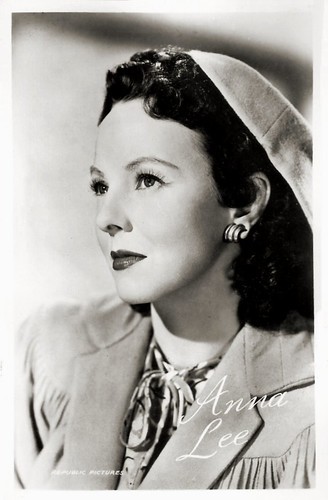
Dutch postcard, no. 3484. Photo: Republic Pictures.
Blue-eyed blonde Anna Lee (1913-2004) was a British-born American actress. She started her career in British films and earned the title 'Queen of the Quota Quickies'. In 1939, she moved to Hollywood with her husband, director Robert Stevenson. There she often worked with John Ford, and later became a TV star in the soap series General Hospital.
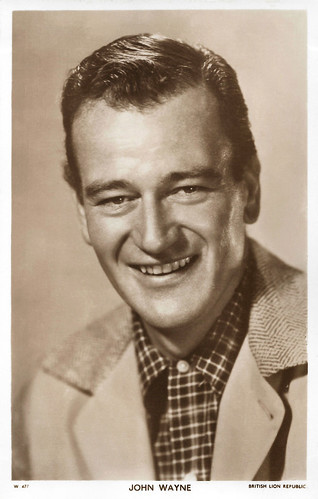
British postcard in the Picturegoer series, London, no W 477. Photo: British Lion / Republic Pictures.
American actor John Wayne (1907-1979) was one of the most popular film stars of the 20th century. He received his first leading film role in The Big Trail (Raoul Walsh, 1930). Working with John Ford, he got his next big break in Stagecoach (1939). His career as an actor took another leap forward when he worked with director Howard Hawks in Red River (1948). Wayne won his first Academy Award in 1969. He starred in 142 films altogether and remains a popular American icon to this day.
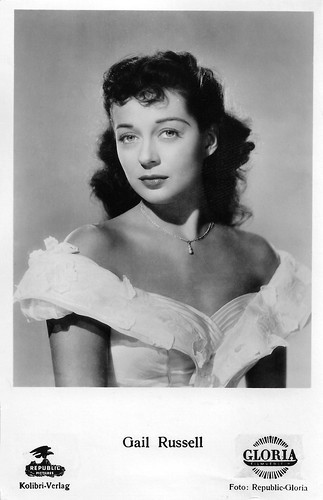
German postcard by Kolibri-Verlag, Minden/Westf. Photo: Republic Pictures / Gloria Filmverleih.
American actress Gail Russell (1924-1961) was an incredible doe-eyed beauty who presented a screen image of great innocence and vulnerability. She is best known for the supernatural horror film The Uninvited (1944). During a promising career at Paramount, she became a victim of alcoholism. It ruined her career, appearance and marriage to Guy Madison . In 1961, she died from liver damage, only 36.
Television as the prop supporting Republic
With production costs increasing, Herbert Yates organised Republic's output into four types of films: ‘Jubilee’, usually a Western shot in seven days for about $50,000; ‘Anniversary’, filmed in 14-15 days for $175,000-$200,000; ‘Deluxe’, major productions made with a budget of around $500,000; and ‘Premiere’, which were usually made by top-rank directors who did not usually work for Republic, such as John Ford, Fritz Lang and Frank Borzage, and which could have a budget of $1,000,000 or more. An example of a 'Premiere' was the Film Noir House by the River (Fritz Lang, 1950) starring Louis Hayward and Jane Wyatt.
Some of these ‘Deluxe’ films were from independent production companies that were picked up for release by Republic. Although Republic made most of its films in black and white, it occasionally produced a higher-budgeted film, such as The Red Pony (Lewis Milestone, 1949) with Myrna Loy and Robert Mitchum , and The Quiet Man (John Ford, 1952), in Technicolor.
During the late 1940s and 1950s Yates utilised a low-cost Cinecolor process called Trucolor in many of his films, including Johnny Guitar (Nicholas Ray, 1954), The Last Command (Frank Lloyd, 1955) with Sterling Hayden and Anna Maria Alberghetti, and Magic Fire (William Dieterle, 1956), starring Yvonne De Carlo and Carlos Thompson . In 1956 Republic came up with its own widescreen film process, Naturama, with The Maverick Queen (Joseph Kane, 1956) the first film made in that process.
Perhaps inspired by the success of American International Pictures catering to teenagers, Republic released several films in the late 1950s about juvenile delinquency such as The Wayward Girl (Lesley Selander, 1957) with Marcia Henderson, Juvenile Jungle (William Witney, 1958) and Young and Wild (William Witney, 1958) starring Gene Evans.
Republic was one of the first Hollywood studios to offer its film library to television. In 1951 Republic established a subsidiary, Hollywood Television Service, to sell screening rights in its vintage Westerns and action thrillers. Many of these films, especially the Westerns, were edited to fit in a one-hour television slot. Hollywood Television Service also produced television shows filmed in the same style as Republic's serials, such as The Adventures of Fu Manchu (Franklin Adreon, 1956). Also, in 1952 the Republic studio lot became the first home of MCA's series factory, Revue Productions.
While it appeared that Republic was well suited for television series production, it did not have the finances or vision to do so. Yet by the mid-1950s, thanks to its sale of old features and leasing of studio space to MCA, television was the prop supporting Republic. During this period the studio produced Commando Cody: Sky Marshal of the Universe (Harry Keller, Franklin Adreon, Fred C. Brannon, 1953). The 12-part serial was unsuccessful as a theatre release, but it was later sold to NBC for television distribution.
Talent agent MCA exerted influence at the studio, bringing in some high-paid clients for occasional features, and it was rumoured at various times that either MCA or deposed MGM head Louis B. Mayer would buy the studio outright. Republic produced The Pride of the Family (Bob Finkel, a.o., 1953-1954), a situation comedy on ABC starring Paul Hartman, Fay Wray and Natalie Wood. The following years, the studio produced Stories of the Century (William Witney, Franklin Andreon, 1954-1955), starring and narrated by Jim Davis. The syndicated series was the first Western to win an Emmy Award.
As the demand and market for films declined with the increasing popularity of television, Republic began to cut back on its films, slowing production from 40 features annually in the early 1950s to 18 in 1957. A tearful Yates informed shareholders at the 1958 annual meeting that feature film production was ending. The distribution offices were shut down the following year.
In 1959 Victor M. Carter, a Los Angeles businessman and turnaround specialist, acquired controlling interest in the floundering company, becoming its president. He turned Republic into a diversified business that included plastics and appliances in addition to its film and studio rentals and Consolidated Film Industries, renaming the company Republic Corporations. Having used the studio for series production for years, Republic began leasing its backlot to other firms, including CBS, in 1963. In 1967 Republic's studio was purchased outright by CBS. Republic sold its library of films to National Telefilm Associates (NTA).
In 1966, Herbert Yates died an extremely wealthy man and eventually left Vera Ralston a very rich widow. The Republic film library is now located at the UCLA Film and Television Archive.
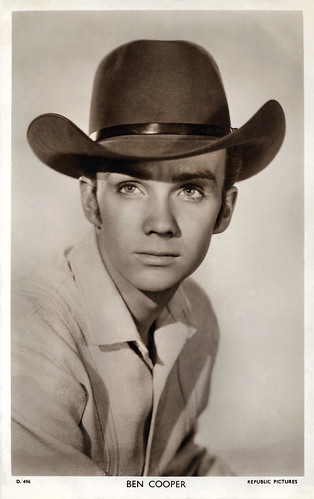
British postcard in the Picturegoer series, no D. 496. Photo: Republic Pictures.
Ben Cooper (1933) is a retired American actor of film and television, who won a Golden Boot Award in 2005 for his work in Westerns. The baby faced leading man appeared as well in Republic Westerns and in many TV Western series.
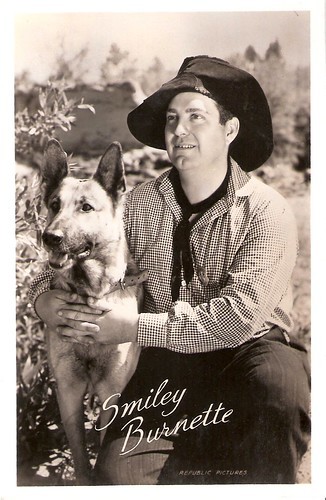
Dutch postcard. Photo: Republic Pictures.
American country music performer and actor Smiley Burnette (1911-1967) was known as Gene Autry's plump, comic sidekick 'Ole Frog' Milhouse in over 60 Westerns. His trademarks were his floppy black hat and his trick voice, imitating a deep, froglike croak. Smiley's career, beginning in 1934, spanned four decades.
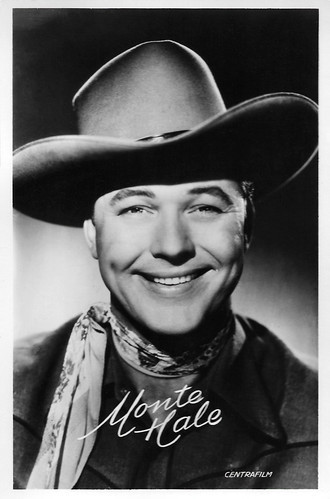
Dutch postcard. Photo: Centrafilm / Republic Pictures.
Monte Hale (1919-2009) was an American B-Western film star and country musician. He was one of the last of the 'singing cowboys' of Republic Pictures.
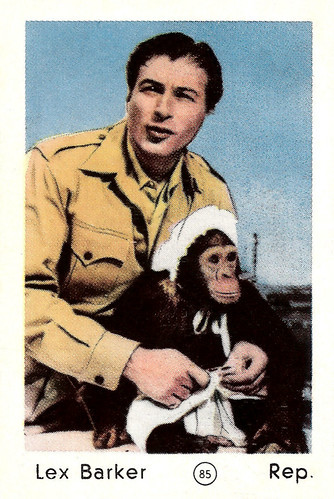
Small German collectors card, no. 85. Photo: Republic.
After a Hollywood career as Tarzan and as Mr. Lana Turner , Lex Barker (1919-1973) moved to Europe. Here he worked with Federico Fellini and later became Old Shatterhand in the popular Karl May film series.
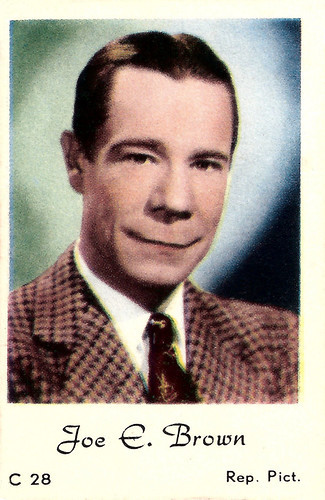
Small collectors card, no. C 28. Photo: Republic Pictures.
American comedian Joe E. Brown (1891-1973) is dearly remembered for his portrayal as Osgood Fielding III in Billy Wilder's Some Like It Hot (1959), in which he utters the famous punchline "Well, nobody's perfect". With his amiable screen persona, comic timing, and enormous elastic-mouth smile, Brown was one of the most popular American comedians in the 1930s and 1940s, with successful films like A Midsummer Night's Dream (1935), Earthworm Tractors (1936) and Alibi Ike (1935).
Sources: Wikipedia and .

Dutch postcard. Photo: Republic Pictures.
American singer and cowboy actor Roy Rogers (1911–1998) was one of the most popular Western stars of his era. Known as the 'King of the Cowboys', he appeared in over 100 films.

British postcard in the Picturegoer Series, London, no. W. 596. Photo: British Lion Republic. Roy Rogers, Dale Evans and Trigger.

British postcard in the Picturegoer Series, London, no. W. 512. Photo: British Lion.
The Sons of the Pioneers are one of the United States' earliest Western singing groups. Known for their vocal performances, their musicianship, and their songwriting, they produced innovative recordings that have inspired many Western music performers and remained popular through the years. Since 1933, through many changes in membership, the Sons of the Pioneers have remained one of the longest-surviving country music vocal groups. Between 1935 and 1984, the Sons of the Pioneers appeared in 87 films.
A studio merger on Poverty Row
In 1935, Republic was created by Herbert J. Yates (1880-1966), a long time investor in film and owner of the film processing laboratory Consolidated Film Industries. Yates had discreetly helped finance Darryl F. Zanuck 's Twentieth Century Pictures in 1933. Zanuck's new studio would become a major customer of Yates' Consolidated Film Industries. Republic was initially formed by Yates' acquisition of six smaller independent studios along Gower Gulch, a section of Gower Street in Hollywood, also called 'Poverty Row'.
In the depths of the Great Depression, Yates' laboratory was no longer servicing the major studios, which had developed their own in-house laboratories for purposes of both economy and control, while the small, independent producers were going under in the face of Depression-born increased competition from the majors combined with the general impact of the depressed economy.
Yates thus decided to create a studio of his own to insure Consolidated's stability. Six surviving small companies (Monogram Pictures, Mascot Pictures, Liberty Pictures, Majestic Pictures, Chesterfield Pictures and Invincible Pictures) were all in debt to his lab. He prevailed upon these studios to merge under his leadership or else face foreclosure on their outstanding lab bills. Yates' new company, Republic Pictures Corporation, was presented to their producer-owners as a collaborative enterprise focused on low-budget product.
The largest of Republic's components was Monogram Pictures, run by producers Trem Carr and W. Ray Johnston, which specialised in B films and operated a nationwide distribution system. The most technologically advanced of the studios that now comprised Republic was Nat Levine's Mascot Pictures Corporation, which had been making serials almost exclusively since the mid-1920s and had a first-class production facility, the former Mack Sennett-Keystone lot in Studio City. Mascot also had just discovered Gene Autry and signed him to a contract as a singing cowboy star.
Larry Darmour's Majestic Pictures had developed an exhibitor following with big-name stars and rented sets giving his humble productions a polished look. Republic took its original Liberty Bell logo from M.H. Hoffman's Liberty Pictures as well as Hoffman's talents as a low-budget film producer. Chesterfield Pictures and Invincible Pictures, two sister companies under the same ownership, were skilled in producing low-budget melodramas and mysteries.
Acquiring and integrating these six companies enabled Republic to begin life with an experienced production staff, a company of veteran B-film supporting players and at least one very promising star, a complete distribution system and a functioning and modern studio. In exchange for merging, the principals were promised independence in their productions under the Republic aegis, and higher budgets with which to improve the quality of the films.
One of the first films Republic released successfully was the Western Westward Ho (Robert N. Bradbury, 1935) starring John Wayne and Sheila Bromley. Another box office hit was the Western Tumbling Tumbleweeds (Joseph Kane, 1935) starring Gene Autry, Smiley Burnette, and George ‘Gabby’ Hayes. Written by Ford Beebe, the film is about a cowboy who returns home after a five-year absence to find his father murdered and his boyhood pal accused of the dastardly deed. Tumbling Tumbleweeds features several songs including the classic 'Tumbling Tumbleweeds'.

Dutch postcard, no. KF 34. Photo: Republic Pictures. Roy Rogers.

Dutch postcard, no. KF 50. Photo: Republic Pictures.
American character actor George 'Gabby' Hayes (1885-1969) was one of the colourful sidekicks to the leading men in the Hollywood Westerns of the 1930s and 1940s. His grizzled codger was so popular that Hayes landed repeatedly on the annual list of Top Ten Western Box-office Stars.

Dutch postcard, no. KF 31. Photo: Republic Pictures.
Gene Autry (1907-1998) was an American singer, and actor who gained fame as a singing cowboy in a crooning style on radio, in films, and on television for more than three decades beginning in the early 1930s. From 1934 to 1953, Autry appeared in 93 films, and between 1950 and 1956 hosted The Gene Autry Show television series.

Belgian postcard by Nieuwe Merksemsche Chocolaterie S.P.R.L., Merksem (Anvers). Photo: Republic.
After achieving modest fame as an ice skater in her native Czechoslovakia, Vera Hruba (1923-2003) was brought to America by Republic Pictures head Herbert J. Yates, who hoped to turn her into the next Sonja Henie . After featuring her in two Ice Capades films, he added Ralston' to her name and tried to pass her off as a leading lady.
A Rise of Dissension in the Ranks
After he had learned the basics of film production and distribution from his partners, Herbert Yates began asserting more and more authority over their film departments, and dissension arose in the ranks. Trem Carr and W. Ray Johnston constantly clashed with Yates, who they felt was a tyrannical Hollywood interloper. They left and reactivated Monogram Pictures in 1937. Larry Darmour resumed independent production for Columbia Pictures.
Nat Levine managed to largely remain out of the fray, and by using many of the same production techniques he had used at Mascot, the new studio's output came to resemble the best of Levine's Mascot product. Levine was later bought out by Yates. Republic could also boast of having the best special effects department (then called 'miniatures') in the industry, which was headed by former Mascot employees Howard Lydecker and his brother Theodore Lydecker. This was a factor that greatly contributed to the quality level of Republic's output. Republic was often contracted by the major studios to provide special effects and miniature work for them.
Meanwhile, Yates installed a staff of new, associate producers who were loyal to him. Freed of partners, Yates presided over what was now his film studio and acquiring senior production and management staff who served him as employees, not experienced peers with independent ideas and agendas. Republic also acquired Brunswick Records to record its singing cowboys Gene Autry and Roy Rogers and hired Cy Feuer as head of its music department.
In its early years Republic was itself sometimes labelled a ‘Poverty Row’ company, as its primary products were B films and serials. Republic, however, showed more interest in — and provided larger budgets to — these films than many of the larger studios were doing, and certainly more than other independents were able to. The heart of the company was its Westerns, and its many Western-film leads — among them John Wayne, Gene Autry, Rex Allen and Roy Rogers — became recognisable stars at Republic.
However, by the mid-1940s Yates was producing better-quality pictures, mounting big-budget fare like Sands of Iwo Jima (Allan Dwan, 1949) starring John Wayne, The Quiet Man (John Ford, 1952) with John Wayne and Maureen O'Hara , Johnny Guitar (Nicholas Ray, 1954) with Joan Crawford and Sterling Hayden, and The Maverick Queen (Joseph Kane, 1956) featuring Barbara Stanwyck. Another distinguishing aspect of the studio was Yates' avoidance of any controversial subject matter, adhering to the Breen Office, in contrast to the other studios which dodged the Production Code.
From the mid-1940s Republic films often featured Vera Hruba Ralston, a former ice-skater from Czechoslovakia who had won the heart of studio boss Yates, becoming the second Mrs. Yates in 1949. She was originally featured in musicals as Republic's answer to Sonja Henie , but Yates tried to build her up as a dramatic star, casting her in leading roles opposite important male stars. Yates billed her as 'the most beautiful woman in films', but her charms were lost on the cinema audiences and exhibitors complained that Republic was making too many Ralston pictures. Years later, John Wayne admitted that the reason he left Republic in 1952 was the threat of having to make another picture with Miss Ralston. Yates remained Ralston's biggest supporter, and she continued to appear in Republic features until its very last production.

British postcard in the Picturegoer series, London, no. D 298. Photo: Republic Pictures.
American actress Mala Powers (1931-2007) played the lovely Roxanne opposite José Ferrer in Cyrano de Bergerac (1950) and starred in other Hollywood films of the 1950s. She was a leading authority on the acting techniques of Russian-American theatre practitioner Michael Chekhov.

British postcard in the Picturegoer Series, London, no. W. 936. Photo: Republic Pictures.
Vivacious blue-eyed blonde Penny Edwards (1928-1998) was an American actress who performed on stage, in films, and on television. She made about two dozen films, initially working at Warners and Universal in the 1940s. She was under a term players contract at Republic Pictures from May, 1950 through October, 1951. At Republic, Edwards did mostly Westerns - six with Roy Rogers and one each with Rex Allen and Allan Lane.

Dutch postcard, no. 3484. Photo: Republic Pictures.
Blue-eyed blonde Anna Lee (1913-2004) was a British-born American actress. She started her career in British films and earned the title 'Queen of the Quota Quickies'. In 1939, she moved to Hollywood with her husband, director Robert Stevenson. There she often worked with John Ford, and later became a TV star in the soap series General Hospital.

British postcard in the Picturegoer series, London, no W 477. Photo: British Lion / Republic Pictures.
American actor John Wayne (1907-1979) was one of the most popular film stars of the 20th century. He received his first leading film role in The Big Trail (Raoul Walsh, 1930). Working with John Ford, he got his next big break in Stagecoach (1939). His career as an actor took another leap forward when he worked with director Howard Hawks in Red River (1948). Wayne won his first Academy Award in 1969. He starred in 142 films altogether and remains a popular American icon to this day.

German postcard by Kolibri-Verlag, Minden/Westf. Photo: Republic Pictures / Gloria Filmverleih.
American actress Gail Russell (1924-1961) was an incredible doe-eyed beauty who presented a screen image of great innocence and vulnerability. She is best known for the supernatural horror film The Uninvited (1944). During a promising career at Paramount, she became a victim of alcoholism. It ruined her career, appearance and marriage to Guy Madison . In 1961, she died from liver damage, only 36.
Television as the prop supporting Republic
With production costs increasing, Herbert Yates organised Republic's output into four types of films: ‘Jubilee’, usually a Western shot in seven days for about $50,000; ‘Anniversary’, filmed in 14-15 days for $175,000-$200,000; ‘Deluxe’, major productions made with a budget of around $500,000; and ‘Premiere’, which were usually made by top-rank directors who did not usually work for Republic, such as John Ford, Fritz Lang and Frank Borzage, and which could have a budget of $1,000,000 or more. An example of a 'Premiere' was the Film Noir House by the River (Fritz Lang, 1950) starring Louis Hayward and Jane Wyatt.
Some of these ‘Deluxe’ films were from independent production companies that were picked up for release by Republic. Although Republic made most of its films in black and white, it occasionally produced a higher-budgeted film, such as The Red Pony (Lewis Milestone, 1949) with Myrna Loy and Robert Mitchum , and The Quiet Man (John Ford, 1952), in Technicolor.
During the late 1940s and 1950s Yates utilised a low-cost Cinecolor process called Trucolor in many of his films, including Johnny Guitar (Nicholas Ray, 1954), The Last Command (Frank Lloyd, 1955) with Sterling Hayden and Anna Maria Alberghetti, and Magic Fire (William Dieterle, 1956), starring Yvonne De Carlo and Carlos Thompson . In 1956 Republic came up with its own widescreen film process, Naturama, with The Maverick Queen (Joseph Kane, 1956) the first film made in that process.
Perhaps inspired by the success of American International Pictures catering to teenagers, Republic released several films in the late 1950s about juvenile delinquency such as The Wayward Girl (Lesley Selander, 1957) with Marcia Henderson, Juvenile Jungle (William Witney, 1958) and Young and Wild (William Witney, 1958) starring Gene Evans.
Republic was one of the first Hollywood studios to offer its film library to television. In 1951 Republic established a subsidiary, Hollywood Television Service, to sell screening rights in its vintage Westerns and action thrillers. Many of these films, especially the Westerns, were edited to fit in a one-hour television slot. Hollywood Television Service also produced television shows filmed in the same style as Republic's serials, such as The Adventures of Fu Manchu (Franklin Adreon, 1956). Also, in 1952 the Republic studio lot became the first home of MCA's series factory, Revue Productions.
While it appeared that Republic was well suited for television series production, it did not have the finances or vision to do so. Yet by the mid-1950s, thanks to its sale of old features and leasing of studio space to MCA, television was the prop supporting Republic. During this period the studio produced Commando Cody: Sky Marshal of the Universe (Harry Keller, Franklin Adreon, Fred C. Brannon, 1953). The 12-part serial was unsuccessful as a theatre release, but it was later sold to NBC for television distribution.
Talent agent MCA exerted influence at the studio, bringing in some high-paid clients for occasional features, and it was rumoured at various times that either MCA or deposed MGM head Louis B. Mayer would buy the studio outright. Republic produced The Pride of the Family (Bob Finkel, a.o., 1953-1954), a situation comedy on ABC starring Paul Hartman, Fay Wray and Natalie Wood. The following years, the studio produced Stories of the Century (William Witney, Franklin Andreon, 1954-1955), starring and narrated by Jim Davis. The syndicated series was the first Western to win an Emmy Award.
As the demand and market for films declined with the increasing popularity of television, Republic began to cut back on its films, slowing production from 40 features annually in the early 1950s to 18 in 1957. A tearful Yates informed shareholders at the 1958 annual meeting that feature film production was ending. The distribution offices were shut down the following year.
In 1959 Victor M. Carter, a Los Angeles businessman and turnaround specialist, acquired controlling interest in the floundering company, becoming its president. He turned Republic into a diversified business that included plastics and appliances in addition to its film and studio rentals and Consolidated Film Industries, renaming the company Republic Corporations. Having used the studio for series production for years, Republic began leasing its backlot to other firms, including CBS, in 1963. In 1967 Republic's studio was purchased outright by CBS. Republic sold its library of films to National Telefilm Associates (NTA).
In 1966, Herbert Yates died an extremely wealthy man and eventually left Vera Ralston a very rich widow. The Republic film library is now located at the UCLA Film and Television Archive.

British postcard in the Picturegoer series, no D. 496. Photo: Republic Pictures.
Ben Cooper (1933) is a retired American actor of film and television, who won a Golden Boot Award in 2005 for his work in Westerns. The baby faced leading man appeared as well in Republic Westerns and in many TV Western series.

Dutch postcard. Photo: Republic Pictures.
American country music performer and actor Smiley Burnette (1911-1967) was known as Gene Autry's plump, comic sidekick 'Ole Frog' Milhouse in over 60 Westerns. His trademarks were his floppy black hat and his trick voice, imitating a deep, froglike croak. Smiley's career, beginning in 1934, spanned four decades.

Dutch postcard. Photo: Centrafilm / Republic Pictures.
Monte Hale (1919-2009) was an American B-Western film star and country musician. He was one of the last of the 'singing cowboys' of Republic Pictures.

Small German collectors card, no. 85. Photo: Republic.
After a Hollywood career as Tarzan and as Mr. Lana Turner , Lex Barker (1919-1973) moved to Europe. Here he worked with Federico Fellini and later became Old Shatterhand in the popular Karl May film series.

Small collectors card, no. C 28. Photo: Republic Pictures.
American comedian Joe E. Brown (1891-1973) is dearly remembered for his portrayal as Osgood Fielding III in Billy Wilder's Some Like It Hot (1959), in which he utters the famous punchline "Well, nobody's perfect". With his amiable screen persona, comic timing, and enormous elastic-mouth smile, Brown was one of the most popular American comedians in the 1930s and 1940s, with successful films like A Midsummer Night's Dream (1935), Earthworm Tractors (1936) and Alibi Ike (1935).
Sources: Wikipedia and .
Published on June 09, 2019 22:00
June 8, 2019
Claudia Cardinale is here
La Cardinale is in town! CC visits Amsterdam as a special guest of the Italian film week 'Fare Cinema'. Tonight, she will be interviewed before the screening of Luchino Visconti's Il gattopardo (1963) in EYE Filmmuseum. Yesterday, Ivo Blom met her at a cocktail party at the Waldorf Astoria in Amsterdam and presented her his book 'Reframing Luchino Visconti'. For this post at EFSP, I use a series of Czech collectors cards, which I recently acquired. The cards were published in 1965 after Cardinale's visit to the Karlovy Vary International Film Festival in 1964.
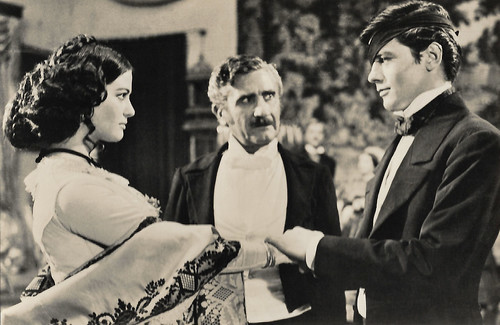
Small Czech collectors card by Pressfoto, Praha (Prague), no. S 101/6. Photo: Claudia Cardinale , Paolo Stoppa and Alain Delon in Il gattopardo/The Leopard (Luchino Visconti, 1963).
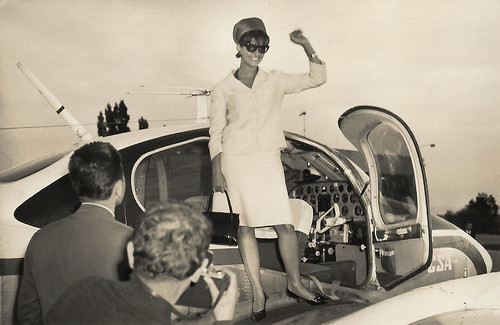
Small Czech collectors card by Pressfoto, Praha (Prague), no. S 101/10. Photo: Claudia Cardinale arrives at the Karlovy Vary International Film Festival in 1964.

Small Czech collectors card by Pressfoto, Praha (Prague), no. S 101/7. Photo: Claudia Cardinale in La ragazza di Bube/Bebo's Girl (Luigi Comencini, 1964), the film which was presented at the Karlovy Vary International Film Festival.
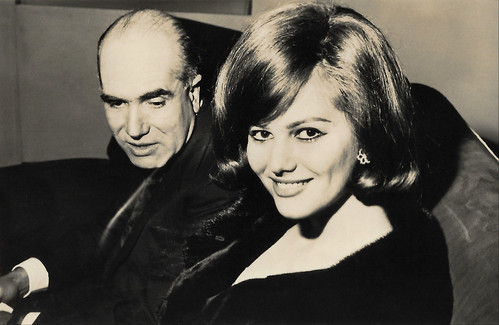
Small Czech collectors card by Pressfoto, Praha (Prague), no. S 101/8. Claudia Cardinale and director Luigi Comencini, director of La ragazza di Bube/Bebo's Girl (1964), at Karlovy Vary International Film Festival.
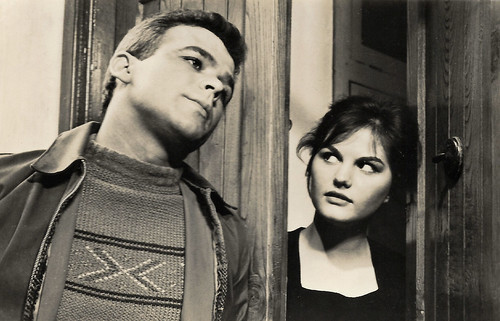
Small Czech collectors card by Pressfoto, Praha (Prague), no. S 101/3. Photo: Claudia Cardinale and Renato Salvatori in Audace colpo dei soliti ignoti/Fiasco in Milan (Nanni Loy, 1959).
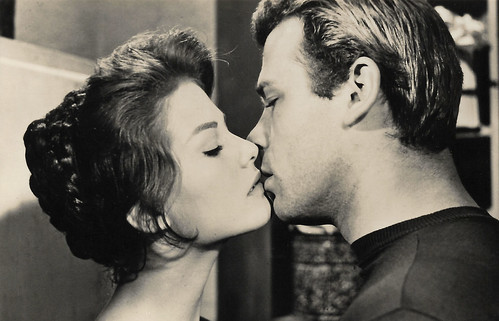
Small Czech collectors card by Pressfoto, Praha (Prague), no. S 101/4. Photo: Claudia Cardinale and Renato Salvatori in Audace colpo dei soliti ignoti/Fiasco in Milan (Nanni Loy, 1959).
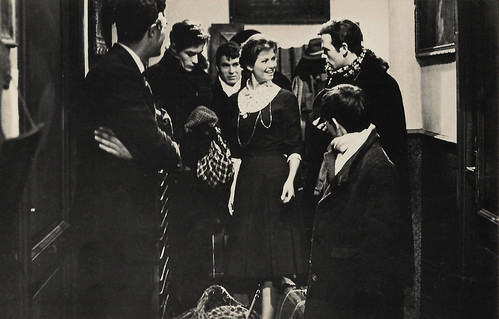
Small Czech collectors card by Pressfoto, Praha (Prague), no. S 101/5. Photo: Claudia Cardinale , Alain Delon , Max Cartier and Renato Salvatori in Rocco e i suoi fratelli/Rocco and His Brothers (Luchino Visconti, 1960).
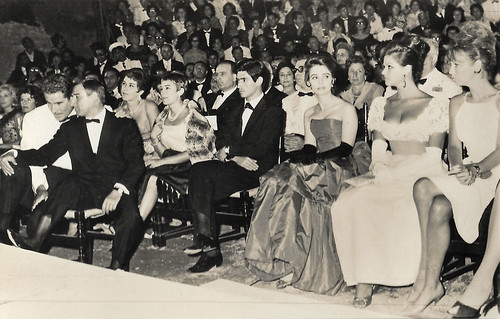
Small Czech collectors card by Pressfoto, Praha (Prague), no. S 101/2. Photo: Claudia Cardinale at the Taormina Film Fest in Sicily, in 1962. The American actress Susan Strasberg is sitting next to her.
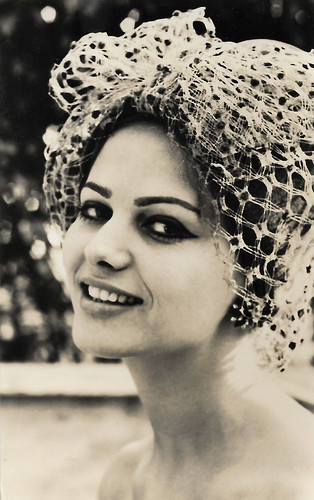
Small Czech collectors card by Pressfoto, Praha (Prague), no. S 101/1, 1965. The retail price was 0,50 Kcs.
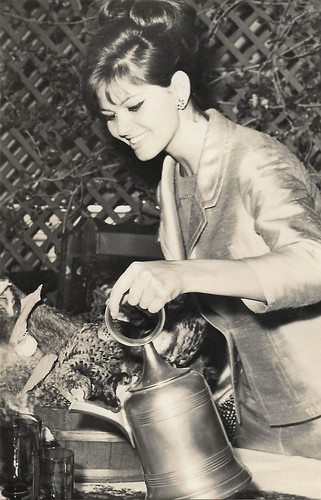
Small Czech collectors card by Pressfoto, Praha (Prague), no. S 101/9, 1965. The retail price was 0,50 Kcs.
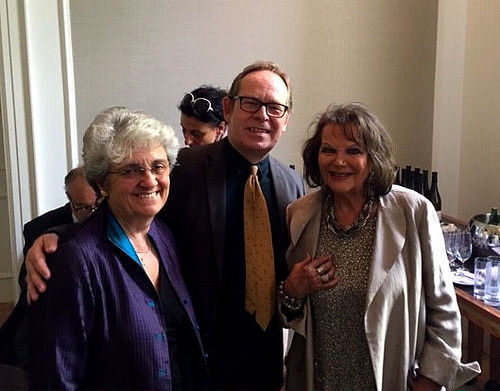
Claudia Cardinale with Caterina D'Amico, producer and former president of the Scuola Nazionale del Cinema (Centro Sperimentale di Cinematografia) in Rome, and Ivo Blom at the Waldorf Astoria Hotel in Amsterdam, 8 June 2019.

Small Czech collectors card by Pressfoto, Praha (Prague), no. S 101/6. Photo: Claudia Cardinale , Paolo Stoppa and Alain Delon in Il gattopardo/The Leopard (Luchino Visconti, 1963).

Small Czech collectors card by Pressfoto, Praha (Prague), no. S 101/10. Photo: Claudia Cardinale arrives at the Karlovy Vary International Film Festival in 1964.

Small Czech collectors card by Pressfoto, Praha (Prague), no. S 101/7. Photo: Claudia Cardinale in La ragazza di Bube/Bebo's Girl (Luigi Comencini, 1964), the film which was presented at the Karlovy Vary International Film Festival.

Small Czech collectors card by Pressfoto, Praha (Prague), no. S 101/8. Claudia Cardinale and director Luigi Comencini, director of La ragazza di Bube/Bebo's Girl (1964), at Karlovy Vary International Film Festival.

Small Czech collectors card by Pressfoto, Praha (Prague), no. S 101/3. Photo: Claudia Cardinale and Renato Salvatori in Audace colpo dei soliti ignoti/Fiasco in Milan (Nanni Loy, 1959).

Small Czech collectors card by Pressfoto, Praha (Prague), no. S 101/4. Photo: Claudia Cardinale and Renato Salvatori in Audace colpo dei soliti ignoti/Fiasco in Milan (Nanni Loy, 1959).

Small Czech collectors card by Pressfoto, Praha (Prague), no. S 101/5. Photo: Claudia Cardinale , Alain Delon , Max Cartier and Renato Salvatori in Rocco e i suoi fratelli/Rocco and His Brothers (Luchino Visconti, 1960).

Small Czech collectors card by Pressfoto, Praha (Prague), no. S 101/2. Photo: Claudia Cardinale at the Taormina Film Fest in Sicily, in 1962. The American actress Susan Strasberg is sitting next to her.

Small Czech collectors card by Pressfoto, Praha (Prague), no. S 101/1, 1965. The retail price was 0,50 Kcs.

Small Czech collectors card by Pressfoto, Praha (Prague), no. S 101/9, 1965. The retail price was 0,50 Kcs.

Claudia Cardinale with Caterina D'Amico, producer and former president of the Scuola Nazionale del Cinema (Centro Sperimentale di Cinematografia) in Rome, and Ivo Blom at the Waldorf Astoria Hotel in Amsterdam, 8 June 2019.
Published on June 08, 2019 22:00
June 7, 2019
Let's do a puzzle
Do you know the phenomenon 'mystery cards'? We have several mystery cards in our collection. Marlene Pilaete defines them as "cards uncorrectly captioned or cards without any name on them or cards on which I have doubts." Sometimes, it’s easy to recognise the actor or actress but, unfortunately, that’s not always the case. Happily we have our own Sherlock, Marlene, who solved some mysteries for us. But now she comes with a mystery of her own. Do you help solving it?
Lucy or Linda?
A few days ago, Marlene wrote us: "I have, since several years, two postcards showing the same Italian silent movie actress wearing the same dress on the two photos. I’ve made the scans for you. One is captioned Lucy San Germano and the other is captioned Linda Moglia . Those two sisters look alike a lot and I haven’t been able to decide so far who is on the postcards: Lucy or Linda? What do Ivo and you think about it?"

Italian postcard by Unione Cinematografica Italiana, Roma, no. 164. Collection: Marlene Pilaete.
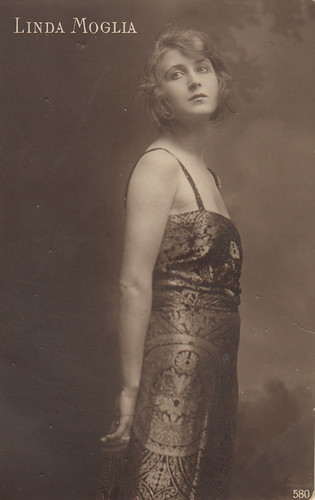
Italian postcard, no. 580. Collection: Marlene Pilaete.
Linda
What a great postcards! And we also love the dress that's definitively on both postcards.
About the second postcard: we think it must be Linda Moglia. We have a non-tinted postcard of the same picture and it's definitively Linda Moglia .
Moglia, born in 1896, peaked in the Italian silent cinema of the late 1910s and early 1920s. Her biggest role was that of Roxane in Cirano di Bergerac/Cyrano de Bergerac (Augusto Genina, 1923).
This is our postcard:
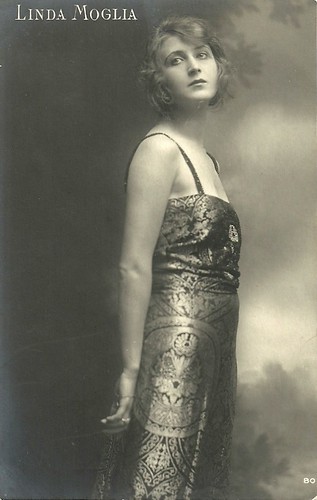
Italian postcard by Fotocelere, Torino, no. 80.
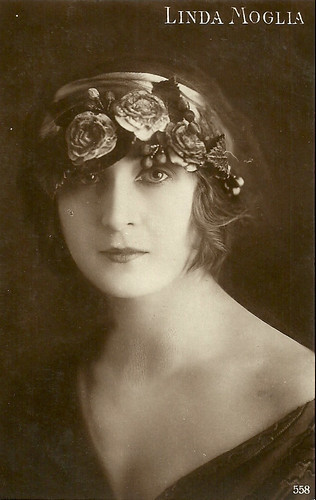
Italian postcard by Ed. A. Traldi, Milano, no. 558.
Lucy
But is she also the actress on the other postcard? Who was Lucy di San Germano ?
Little is known about her private life. She was born in Turin in 1898.
From 1918 on, Sangermano worked for the Ambrosio studio in Turin. Later she worked for studios like Audax and Cines, and Sangermano’s last film was at the Turinese company Fert: L’inafferabile (Mario Almirante 1922), with Alberto Collo .
This is how she looked like:
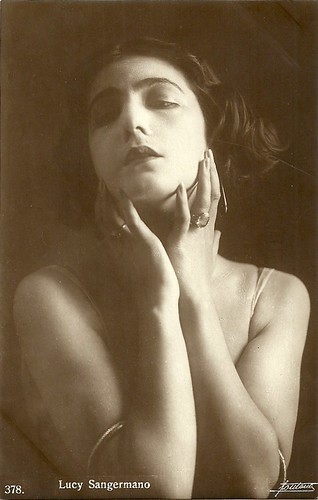
Italian postcard, no. 378. Photo: Fontana.
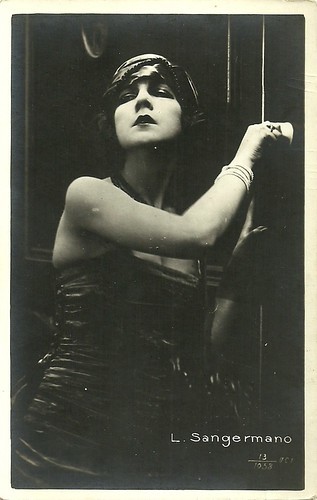
Italian postcard by Ed. G. Vettori, Bologna, no. 13, 1058. Photo: UCI (Unione Cinematografica Italiana).
So, Lucy San Germano looks familiar to Linda Moglia, and yes, like Marlene suggests, they were real sisters: Lucy was Linda's younger sister. Di San Germano was Lucy's stage name, her real name was Lucy Moglia.
The two sisters acted together in one film, Noblesse oblige (1918), based on a boulevard comedy by Maurice Hennequin and Pierre Veber.
The film was apparently directed by the famous poster designer and illustrator Marcello Dudovich, whose only film direction this was.
Noblesse oblige (1918) was an Ambrosio production, so our guess was that Lucy borrowed her sister's dress from this production.
But, what do you think?
Lillian or Renée?
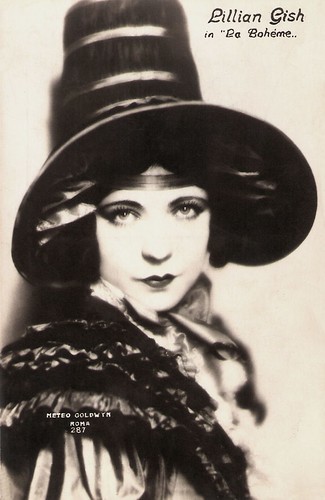
Italian postcard by Casa Editrice Ballerini & Fratini, Firenze. Photo: Metro Goldwyn (MGM), Roma, no. 287. Publicity still for La Bohème (King Vidor, 1926).
Although the postcard credits Lillian Gish , it's actually co-star Renée Adorée who is portrayed.
Thanks to Marlene Pilaete, for mentioning this to us some time ago, and for sending us the puzzle of the dress.
Lucy or Linda?
A few days ago, Marlene wrote us: "I have, since several years, two postcards showing the same Italian silent movie actress wearing the same dress on the two photos. I’ve made the scans for you. One is captioned Lucy San Germano and the other is captioned Linda Moglia . Those two sisters look alike a lot and I haven’t been able to decide so far who is on the postcards: Lucy or Linda? What do Ivo and you think about it?"

Italian postcard by Unione Cinematografica Italiana, Roma, no. 164. Collection: Marlene Pilaete.

Italian postcard, no. 580. Collection: Marlene Pilaete.
Linda
What a great postcards! And we also love the dress that's definitively on both postcards.
About the second postcard: we think it must be Linda Moglia. We have a non-tinted postcard of the same picture and it's definitively Linda Moglia .
Moglia, born in 1896, peaked in the Italian silent cinema of the late 1910s and early 1920s. Her biggest role was that of Roxane in Cirano di Bergerac/Cyrano de Bergerac (Augusto Genina, 1923).
This is our postcard:

Italian postcard by Fotocelere, Torino, no. 80.

Italian postcard by Ed. A. Traldi, Milano, no. 558.
Lucy
But is she also the actress on the other postcard? Who was Lucy di San Germano ?
Little is known about her private life. She was born in Turin in 1898.
From 1918 on, Sangermano worked for the Ambrosio studio in Turin. Later she worked for studios like Audax and Cines, and Sangermano’s last film was at the Turinese company Fert: L’inafferabile (Mario Almirante 1922), with Alberto Collo .
This is how she looked like:

Italian postcard, no. 378. Photo: Fontana.

Italian postcard by Ed. G. Vettori, Bologna, no. 13, 1058. Photo: UCI (Unione Cinematografica Italiana).
So, Lucy San Germano looks familiar to Linda Moglia, and yes, like Marlene suggests, they were real sisters: Lucy was Linda's younger sister. Di San Germano was Lucy's stage name, her real name was Lucy Moglia.
The two sisters acted together in one film, Noblesse oblige (1918), based on a boulevard comedy by Maurice Hennequin and Pierre Veber.
The film was apparently directed by the famous poster designer and illustrator Marcello Dudovich, whose only film direction this was.
Noblesse oblige (1918) was an Ambrosio production, so our guess was that Lucy borrowed her sister's dress from this production.
But, what do you think?
Lillian or Renée?

Italian postcard by Casa Editrice Ballerini & Fratini, Firenze. Photo: Metro Goldwyn (MGM), Roma, no. 287. Publicity still for La Bohème (King Vidor, 1926).
Although the postcard credits Lillian Gish , it's actually co-star Renée Adorée who is portrayed.
Thanks to Marlene Pilaete, for mentioning this to us some time ago, and for sending us the puzzle of the dress.
Published on June 07, 2019 22:00
Let's puzzle
Do you know the phenomenon 'mystery cards'? We have several mystery cards in our collection. Marlene Pilaete defines them as "cards uncorrectly captioned or cards without any name on them or cards on which I have doubts." Sometimes, it’s easy to recognise the actor or actress but, unfortunately, that’s not always the case. Happily we have our own Sherlock, Marlene, who solved some mysteries for us. But now she comes with a mystery of her own. Do you help solving it?
Lucy or Linda?
A few days ago, Marlene wrote us: "I have, since several years, two postcards showing the same Italian silent movie actress wearing the same dress on the two photos. I’ve made the scans for you. One is captioned Lucy San Germano and the other is captioned Linda Moglia . Those two sisters look alike a lot and I haven’t been able to decide so far who is on the postcards: Lucy or Linda? What do Ivo and you think about it?"

Italian postcard by Unione Cinematografica Italiana, Roma, no. 164. Collection: Marlene Pilaete.

Italian postcard, no. 580. Collection: Marlene Pilaete.
Linda
What a great postcards! And we also love the dress that's definitively on both postcards.
About the second postcard: we think it must be Linda Moglia. We have a non-tinted postcard of the same picture and it's definitively Linda Moglia .
Moglia, born in 1896, peaked in the Italian silent cinema of the late 1910s and early 1920s. Her biggest role was that of Roxane in Cirano di Bergerac/Cyrano de Bergerac (Augusto Genina, 1923).
This is our postcard:

Italian postcard by Fotocelere, Torino, no. 80.

Italian postcard by Ed. A. Traldi, Milano, no. 558.
Lucy
But is she also the actress on the other postcard? Who was Lucy di San Germano ?
Little is known about her private life. She was born in Turin in 1898.
From 1918 on, Sangermano worked for the Ambrosio studio in Turin. Later she worked for studios like Audax and Cines, and Sangermano’s last film was at the Turinese company Fert: L’inafferabile (Mario Almirante 1922), with Alberto Collo .
This is how she looked like:

Italian postcard, no. 378. Photo: Fontana.

Italian postcard by Ed. G. Vettori, Bologna, no. 13, 1058. Photo: UCI (Unione Cinematografica Italiana).
So, Lucy San Germano looks familiar to Linda Moglia, and yes, like Marlene suggests, they were real sisters: Lucy was Linda's younger sister. Di San Germano was Lucy's stage name, her real name was Lucy Moglia.
The two sisters acted together in one film, Noblesse oblige (1918), based on a boulevard comedy by Maurice Hennequin and Pierre Veber.
The film was apparently directed by the famous poster designer and illustrator Marcello Dudovich, whose only film direction this was.
Noblesse oblige (1918) was an Ambrosio production, so our guess was that Lucy borrowed her sister's dress from this production.
But, what do you think?
Lillian or Renée?

Italian postcard by Casa Editrice Ballerini & Fratini, Firenze. Photo: Metro Goldwyn (MGM), Roma, no. 287. Publicity still for La Bohème (King Vidor, 1926).
Although the postcard credits Lillian Gish , it's actually co-star Renée Adorée who is portrayed.
Thanks to Marlene Pilaete, for mentioning this to us some time ago, and for sending us the puzzle of the dress.
Lucy or Linda?
A few days ago, Marlene wrote us: "I have, since several years, two postcards showing the same Italian silent movie actress wearing the same dress on the two photos. I’ve made the scans for you. One is captioned Lucy San Germano and the other is captioned Linda Moglia . Those two sisters look alike a lot and I haven’t been able to decide so far who is on the postcards: Lucy or Linda? What do Ivo and you think about it?"

Italian postcard by Unione Cinematografica Italiana, Roma, no. 164. Collection: Marlene Pilaete.

Italian postcard, no. 580. Collection: Marlene Pilaete.
Linda
What a great postcards! And we also love the dress that's definitively on both postcards.
About the second postcard: we think it must be Linda Moglia. We have a non-tinted postcard of the same picture and it's definitively Linda Moglia .
Moglia, born in 1896, peaked in the Italian silent cinema of the late 1910s and early 1920s. Her biggest role was that of Roxane in Cirano di Bergerac/Cyrano de Bergerac (Augusto Genina, 1923).
This is our postcard:

Italian postcard by Fotocelere, Torino, no. 80.

Italian postcard by Ed. A. Traldi, Milano, no. 558.
Lucy
But is she also the actress on the other postcard? Who was Lucy di San Germano ?
Little is known about her private life. She was born in Turin in 1898.
From 1918 on, Sangermano worked for the Ambrosio studio in Turin. Later she worked for studios like Audax and Cines, and Sangermano’s last film was at the Turinese company Fert: L’inafferabile (Mario Almirante 1922), with Alberto Collo .
This is how she looked like:

Italian postcard, no. 378. Photo: Fontana.

Italian postcard by Ed. G. Vettori, Bologna, no. 13, 1058. Photo: UCI (Unione Cinematografica Italiana).
So, Lucy San Germano looks familiar to Linda Moglia, and yes, like Marlene suggests, they were real sisters: Lucy was Linda's younger sister. Di San Germano was Lucy's stage name, her real name was Lucy Moglia.
The two sisters acted together in one film, Noblesse oblige (1918), based on a boulevard comedy by Maurice Hennequin and Pierre Veber.
The film was apparently directed by the famous poster designer and illustrator Marcello Dudovich, whose only film direction this was.
Noblesse oblige (1918) was an Ambrosio production, so our guess was that Lucy borrowed her sister's dress from this production.
But, what do you think?
Lillian or Renée?

Italian postcard by Casa Editrice Ballerini & Fratini, Firenze. Photo: Metro Goldwyn (MGM), Roma, no. 287. Publicity still for La Bohème (King Vidor, 1926).
Although the postcard credits Lillian Gish , it's actually co-star Renée Adorée who is portrayed.
Thanks to Marlene Pilaete, for mentioning this to us some time ago, and for sending us the puzzle of the dress.
Published on June 07, 2019 22:00
June 6, 2019
Gary Cooper
American screen legend Gary Cooper (1901-1961) is well remembered for his stoic, understated acting style in more than one hundred Westerns, comedies and dramas. He received five Oscar nominations and won twice for his roles as Alvin York in Sergeant York (1941) and as Will Kane in High Noon (1952).
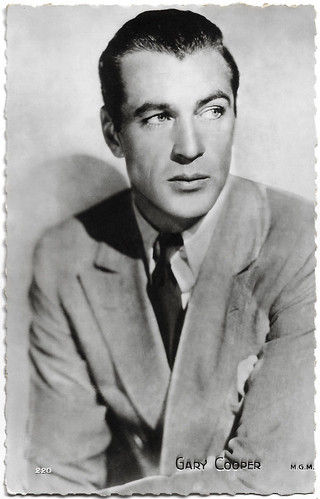
French postcard by Editions P.I., Paris, no. 220. Photo: M.G.M.

British postcard in the 'Film Kurier' Series, London, no. 9. Photo: Paramount Pictures.
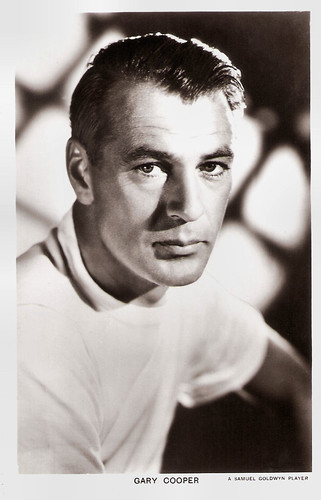
British postcard in the Picturegoer Series, London, no. 868b. Photo: Samuel Goldwyn.
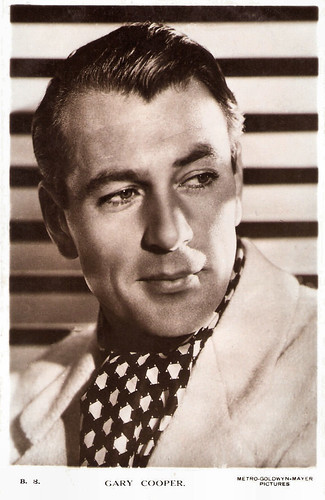
British Real Photograph postcard, no. B. 8. Photo: Metro-Goldwyn-Mayer.
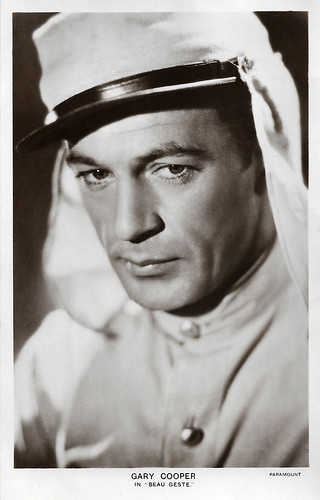
British postcard, London, no. FS 190. Photo: Paramount. Publicity still for Beau Geste (William A. Wellman, 1939).
A dynamic new personality
Frank James Cooper was born in Helena, Montana in 1901. His parents were English immigrants, Alice Cooper-Brazier and Charles Henry Cooper, a prominent lawyer, rancher, and eventually a state supreme court judge.
Frank left school in 1918 and returned to the family ranch to help raise their five hundred head of cattle and work full-time as a cowboy. In 1919, his father arranged for his son to complete his high school education at Gallatin County High School in Bozeman, Montana. His English teacher, Ida W. Davis, played an important role in encouraging him to focus on academics, join the school's debating team, and become involved in dramatics. He was in a car accident as a teenager that caused him to walk with a limp the rest of his life.
In the fall of 1924, Cooper's parents moved to Los Angeles to administer the estates of two relatives. Cooper joined them and there he met some cowboys from Montana who were working as film extras and stuntmen in low-budget Western films. Cooper decided to try his hand working as a film extra for five dollars a day, and as a stuntman for twice that amount.
In early 1925, Cooper began his film career working as an extra and stuntman on Poverty Row in such silent Westerns as Riders of the Purple Sage (Lynn Reynolds, 1925) with Tom Mix, and The Trail Rider (W.S. Van Dyke, 1925) with Buck Jones. Cooper paid for a screen test and hired casting director Nan Collins to work as his agent. Collins changed his first name to ‘Gary’ after her hometown of Gary, Indiana.
Cooper also worked in non-Western films. He appeared as a masked Cossack in The Eagle (Clarence Brown, 1925) with Rudolph Valentino , as a Roman guard in Ben-Hur (Fred Niblo, 1925) with Ramon Novarro , and as a flood survivor in The Johnstown Flood (Irving Cummings, 1926) with George O'Brien.
Gradually he began to land credited roles that offered him more screen time, such as Tricks (Bruce M. Mitchell, 1925), in which he played the film's antagonist. As a featured player, he began to attract the attention of major film studios and in June 1926, Cooper signed a contract with Samuel Goldwyn Productions.
His first important film role was in The Winning of Barbara Worth (Henry King, 1926) with Ronald Colman and Vilma Bánky . The film was a major success, and critics called Cooper a "dynamic new personality" and future star.
Cooper signed a five-year contract with Jesse L. Lasky at Paramount Pictures for $175 per week. In 1927, with help from established silent film star Clara Bow, Cooper landed high-profile roles opposite her in Children of Divorce (Frank Lloyd, 1927) and Wings (William A. Wellman, 1927), the first film to win an Academy Award for Best Picture.
With each new film, Cooper's acting skills improved and his popularity continued to grow, especially among female film-goers. He received a thousand fan letters per week. The studio placed him opposite popular leading ladies in films such as Beau Sabreur (John Waters, 1928) with Evelyn Brent, Half a Bride (Gregory La Cava, 1928) with Esther Ralston, and Lilac Time (George Fitzmaurice, 1928) with Colleen Moore . The latter introduced synchronised music and sound effects, and became one of the biggest box office hits of the year.
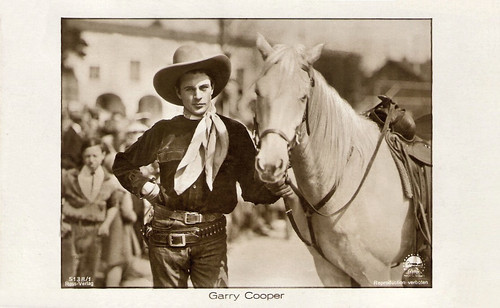
German postcard by Ross-Verlag, no. 5138/1, 1930-1931. Photo: Paramount. Publicity still for The Last Outlaw (Arthur Rosson, 1927). Cooper was in this silent Western credited as 'Garry Cooper'.
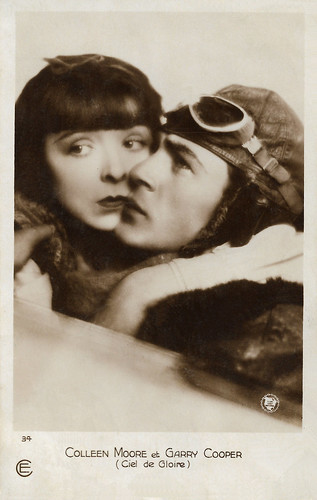
French postcard by Cinémagazine-Edition, no. 34. Photo: First National. Colleen Moore and Gary Cooper in Lilac Time (George Fitzmaurice, 1928).
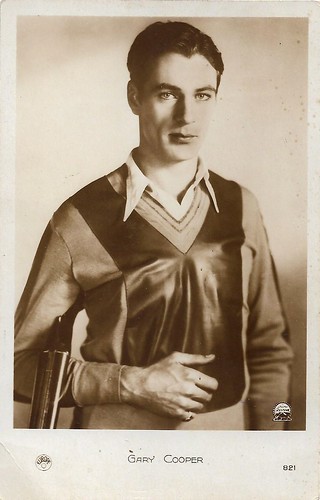
French postcard by Europe, no. 821. Photo: Paramount.
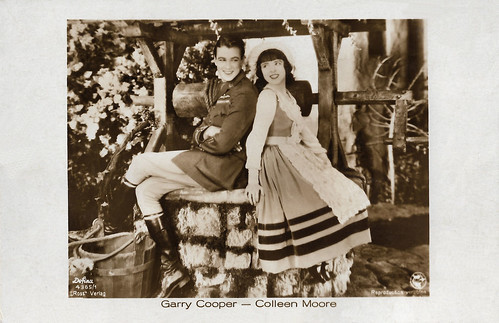
German postcard by Ross Verlag, no. 4365/1, 1929-1930. Photo: Defina / First National. Colleen Moore and Gary Cooper in Lilac Time (George Fitzmaurice, 1928).
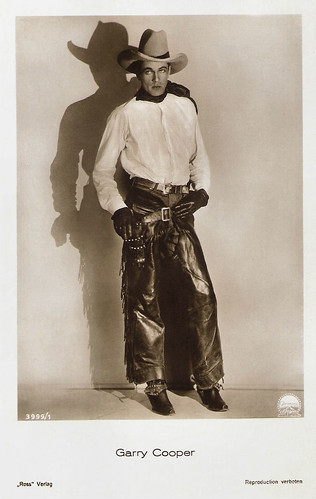
German postcard by Ross Verlag, no. 3999/1, 1928-1929. Photo: Paramount.
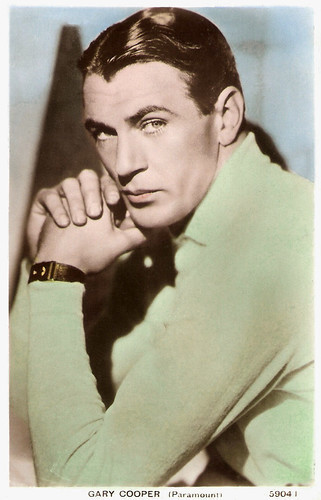
British Valentine's postcard, no. 5904 I. Photo: Paramount.
The tall, handsome and shy cowboy
In 1929, Gary Cooper became a major film star with his first sound picture, The Virginian (Victor Fleming, 1929). The Virginian was one of the first sound films to define the Western code of honour and helped establish many of the conventions of the Western genre. The romantic image of the tall, handsome, and shy cowboy hero that embodied male freedom, courage, and honour was created in large part by Cooper's performance in the film.
Cooper transitioned naturally to the sound medium, with his deep, clear and pleasantly drawling voice. One of the high points of Cooper's early career was his portrayal of a sullen legionnaire in Josef von Sternberg's Morocco (1930) with Marlene Dietrich in her American debut. Cooper produced one of his finest performances to that point in his career.
In the Dashiell Hammett crime drama City Streets (Rouben Mamoulian, 1931) he played a misplaced cowboy in a big city who gets involved with gangsters to save the woman (Sylvia Sidney) he loves.
After making ten films in two years Cooper was exhausted and had lost thirty pounds. In May 1931, he sailed to Algiers and then to Italy, where he lived for the next year. During his time abroad, Cooper stayed with the Countess Dorothy di Frasso who taught him about good food and vintage wines, how to read Italian and French menus in the finest restaurants, and how to socialise among Europe's nobility and upper classes.
In 1932, a healthy Cooper returned to Hollywood and negotiated a new contract with Paramount for two films per year, a salary of $4,000 per week, and director and script approval. He appeared opposite Helen Hayes in A Farewell to Arms (Frank Borzage, 1932), the first film adaptation of an Ernest Hemingway novel. Critics praised his highly intense and at times emotional performance, and the film went on to become one of the year's most commercially successful films.
The following year, Cooper appeared in the Ernst Lubitsch comedy Design for Living (1933) with Miriam Hopkins and Fredric March, and based loosely on the successful Noël Coward play. Wikipedia : “The film received mixed reviews and did not do well at the box office, but Cooper's performance was singled out for its versatility and revealed his genuine ability to do light comedy”.
Then, he appeared in his first of seven films by director Henry Hathaway, Now and Forever (1934), with Carole Lombard and Shirley Temple. The film was a box-office success. His next two Henry Hathaway films were the melodrama Peter Ibbetson (1935) with Ann Harding, about a man caught up in a dream world created by his love for a childhood sweetheart, and the romantic adventure The Lives of a Bengal Lancer (1935), about a daring British officer and his men who defend their stronghold at Bengal against rebellious local tribes. The latter was nominated for six Academy Awards and became one of Cooper's most popular and successful adventure films.
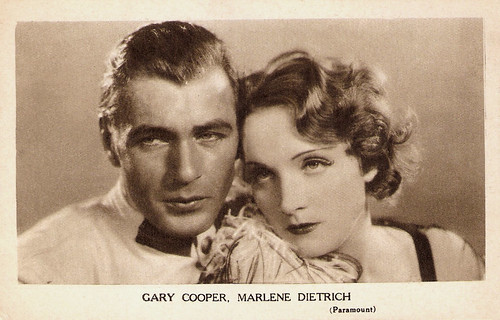
Belgian postcard. Photo: Paramount. Marlene Dietrich and Gary Cooper in Morocco (Josef von Sternberg, 1930).
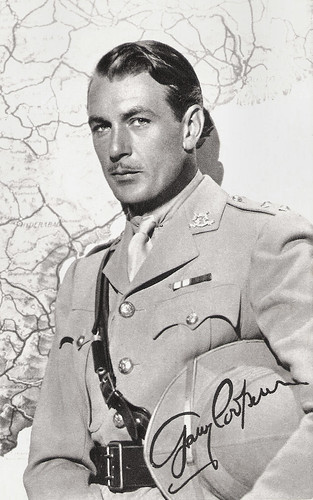
British Real Photogravure Portrait. Photo: Paramount. Publicity still for The Lives of a Bengal Lancer (Henry Hathaway, 1935).
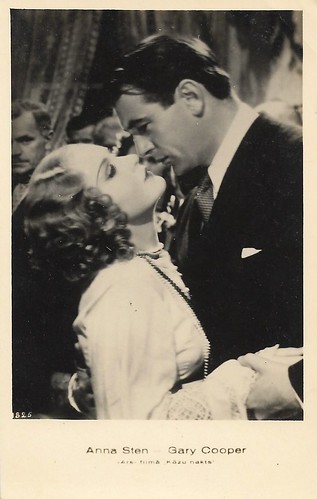
Latvian postcard. Anna Sten and Gary Cooper in The Wedding Night (King Vidor, 1935).
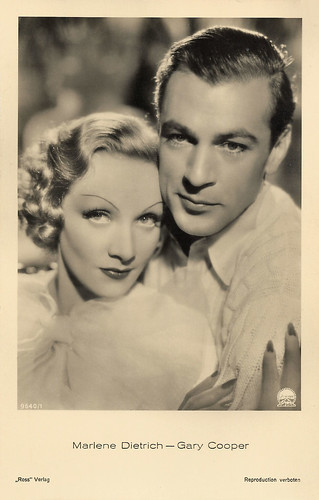
German postcard by Ross Verlag, no. 9640/1, 1935-1936. Photo: Paramount. Marlene Dietrich and Gary Cooper in Desire (Frank Borzage, 1936).
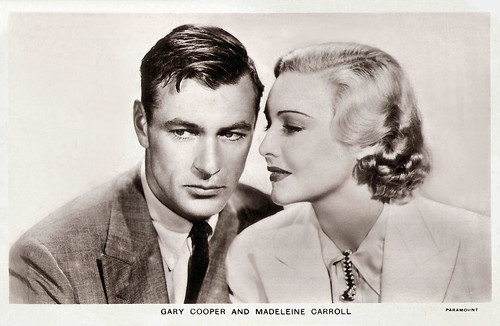
British postcard in the Film Partners series, no. P 214. Photo: Paramount. Madeleine Carroll and Gary Cooper in The General Died at Dawn (Lewis Milestone, 1936).
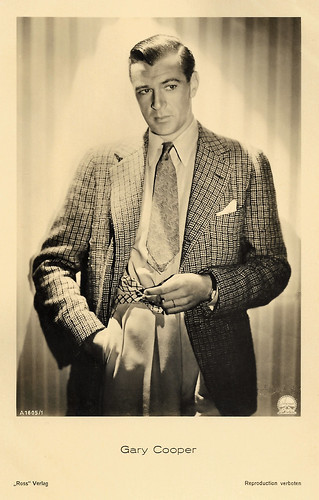
German postcard by Ross Verlag, no. A 1605/1, 1937-1938. Photo: Paramount.
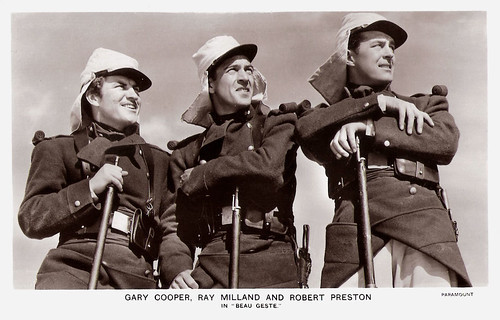
British postcard, London, no. FS 191. Photo: Paramount. Robert Preston, Gary Cooper and Ray Milland in Beau Geste (William A. Wellman, 1939).
An ‘open’ marriage
Gary Cooper returned to Poverty Row for the first time since his early silent film days to make Mr. Deeds Goes to Town (Frank Capra, 1936) with Jean Arthur for Columbia Pictures. Cooper plays the character of Longfellow Deeds, an innocent, sweet-natured writer of greeting cards who inherits a fortune, leaves behind his idyllic life in Vermont, and travels to New York where he faces a world of corruption and deceit. For his performance in Mr. Deeds, Cooper received his first Oscar nomination.
In the adventure film The General Died at Dawn (Lewis Milestone, 1936) with Madeleine Carroll , he plays an American soldier of fortune in China who helps the peasants defend themselves against the oppression of a cruel warlord. Written by playwright Clifford Odets, the film was a critical and commercial success.
In Cecil B. DeMille's sprawling frontier epic The Plainsman (1936) with Jean Arthur — his first of four films with the director — Cooper portrays Wild Bill Hickok in a highly-fictionalised version of the opening of the American western frontier. That year, Cooper appeared for the first time on the Motion Picture Herald exhibitor's poll of top ten film personalities, where he would remain for the next twenty-two years.
In Ernst Lubitsch 's romantic comedy Bluebeard's Eighth Wife (1938) with Claudette Colbert , Cooper plays a wealthy American businessman in France who falls in love with an impoverished aristocrat's daughter and persuades her to become his eighth wife.
In the adventure film Beau Geste (William A. Wellman, 1939) with Ray Milland , he joined the French Foreign Legion to find adventure in the Sahara fighting local tribes. Wikipedia : “Beau Geste provided Cooper with magnificent sets, exotic settings, high-spirited action, and a role tailored to his personality and screen persona.”
Cooper cemented his cowboy credentials in The Westerner (William Wyler, 1940). He won his first Academy Award for Best Actor in 1942 for his performance as Alvin York, the most decorated U.S. soldier from the Great War, in Sergeant York (Howard Hawks, 1941).
Cooper worked with Ingrid Bergman in For Whom the Bell Tolls (Sam Wood, 1943) which earned him his third Oscar nomination. The film was based on a novel by Ernest Hemingway, with whom Cooper developed a strong friendship.
On 23 October 1947, he appeared before the House Un-American Activities Committee in Washington, not under subpoena but responding to an invitation to give testimony on the alleged infiltration of Hollywood by communists. Although he never said he regretted having been a friendly witness, as an independent producer, he hired blacklisted actors and technicians. He did say he had never wanted to see anyone lose the right to work, regardless of what he had done.
Cooper won his second Oscar for his performance as Marshal Will Kane in High Noon (Fred Zinnemann, 1952), one of his finest roles and a kind of come-back after a series of flops. He continued to play the lead in films almost to the end of his life.
His later box office hits included the influential Western Vera Cruz (Robert Aldrich, 1954) in which he guns down villain Burt Lancaster in a showdown, William Wyler's Friendly Persuasion (1956), in which he portrays a Quaker farmer during the American Civil War, Billy Wilder's Love in the Afternoon (1957) with Audrey Hepburn , and the hard-edged action Western Man of the West (Anthony Mann, 1958), with Lee J. Cobb.
Cooper's final film was the British-American co-production The Naked Edge (Michael Anderson, 1961). In April 1960, Cooper underwent surgery for prostate cancer after it had metastasized to his colon. But by the end of the year the cancer had spread to his lungs and bones. On 13 May 1961, six days after his sixtieth birthday, Gary Cooper died.
The young and handsome Cooper had affairs with Clara Bow, Lupe Velez, Marlene Dietrich and Tallulah Bankhead. In 1933, he married socialite Veronica Balfe, who, billed as Sandra Shaw, enjoyed a short-lived acting career. They had an ‘open’ marriage and Cooper also had relationships with the actresses Grace Kelly , Anita Ekberg , and Patricia Neal. Sir Cecil Beaton also claimed to have had an affair with him.
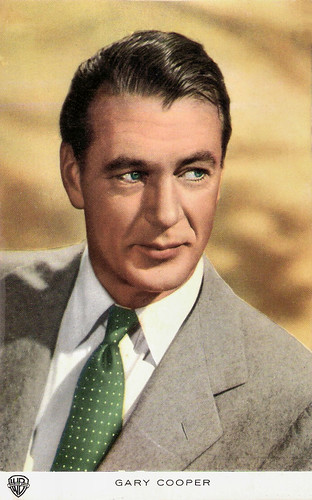
Belgian postcard by N.V. Victoria, Brussels, no. 639. Photo: Warner Bros.
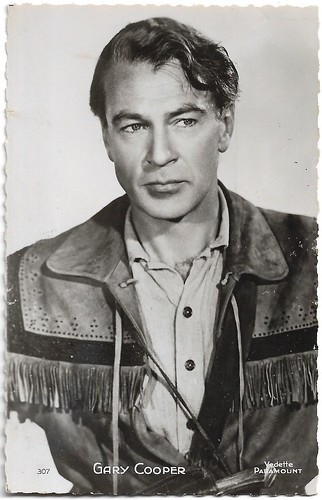
French postcard by Editions P.I., Paris, no. 307. Photo: Paramount. Gary Cooper in Unconquered (Cecil B. DeMille, 1947).
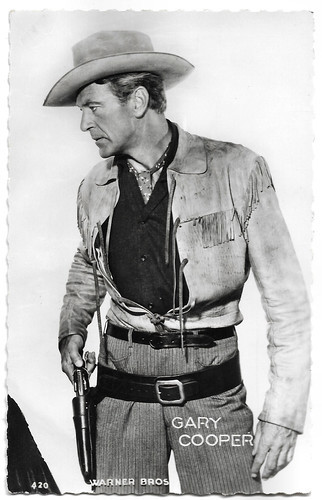
French postcard by Editions P.I., Paris, no. 19E. Photo: Warner Bros, 1953. Gary Cooper in Dallas (Henry Hathaway, 1950).
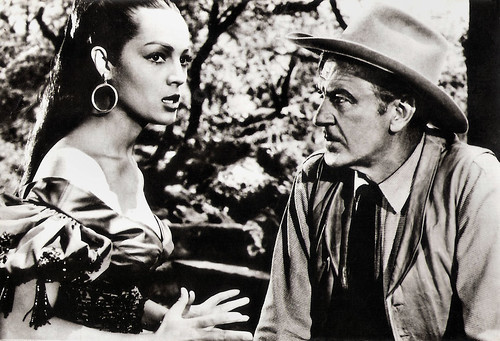
Romanian postcard by Casa Filmului Acin, no. 40. Photo: United Artists. Sara Montiel and Gary Cooper in Vera Cruz (Robert Aldrich, 1954).
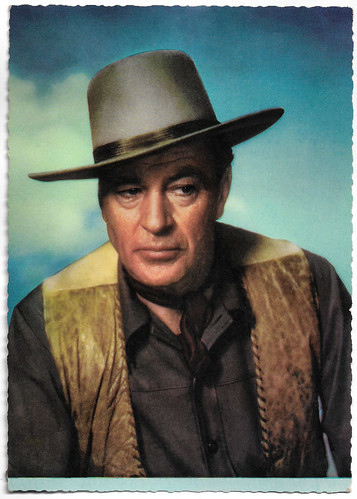
German postcard by ISV, no. A 17. Photo: 20th Century Fox. Gary Cooper in Garden of Evil (Henry Hathaway, 1954).
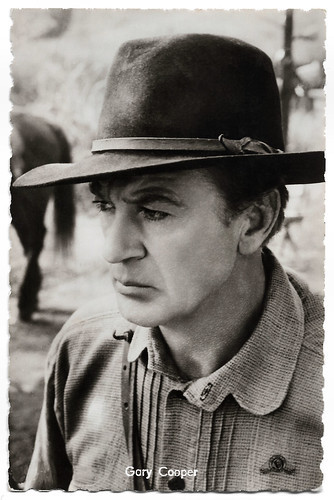
German postcard by Kolibri-Verlag, Minden/Westf.no. 2892. Photo: MGM. Publicity still for Friendly Persuasion (William Wyler, 1956).
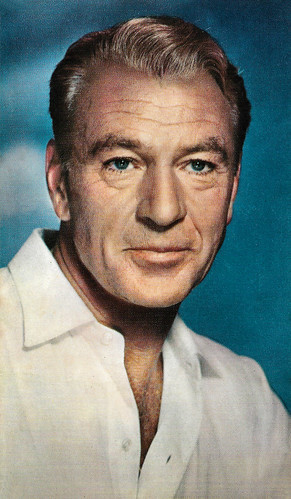
French postcard by PSG, offered by Corvisart, Epinal, no. 49.
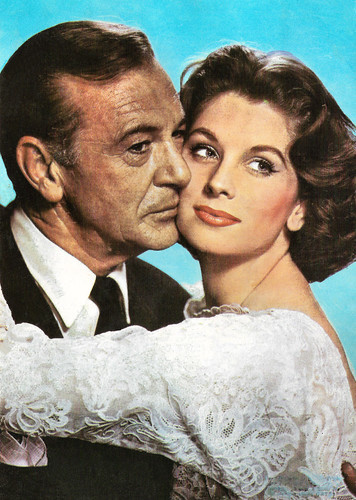
Romanian postcard by Casa Filmului ACIN. Photo: Gary Cooper and Suzy Parker in Ten North Frederick (Philip Dunne, 1958).
Sources: Wikipedia and .

French postcard by Editions P.I., Paris, no. 220. Photo: M.G.M.

British postcard in the 'Film Kurier' Series, London, no. 9. Photo: Paramount Pictures.

British postcard in the Picturegoer Series, London, no. 868b. Photo: Samuel Goldwyn.

British Real Photograph postcard, no. B. 8. Photo: Metro-Goldwyn-Mayer.

British postcard, London, no. FS 190. Photo: Paramount. Publicity still for Beau Geste (William A. Wellman, 1939).
A dynamic new personality
Frank James Cooper was born in Helena, Montana in 1901. His parents were English immigrants, Alice Cooper-Brazier and Charles Henry Cooper, a prominent lawyer, rancher, and eventually a state supreme court judge.
Frank left school in 1918 and returned to the family ranch to help raise their five hundred head of cattle and work full-time as a cowboy. In 1919, his father arranged for his son to complete his high school education at Gallatin County High School in Bozeman, Montana. His English teacher, Ida W. Davis, played an important role in encouraging him to focus on academics, join the school's debating team, and become involved in dramatics. He was in a car accident as a teenager that caused him to walk with a limp the rest of his life.
In the fall of 1924, Cooper's parents moved to Los Angeles to administer the estates of two relatives. Cooper joined them and there he met some cowboys from Montana who were working as film extras and stuntmen in low-budget Western films. Cooper decided to try his hand working as a film extra for five dollars a day, and as a stuntman for twice that amount.
In early 1925, Cooper began his film career working as an extra and stuntman on Poverty Row in such silent Westerns as Riders of the Purple Sage (Lynn Reynolds, 1925) with Tom Mix, and The Trail Rider (W.S. Van Dyke, 1925) with Buck Jones. Cooper paid for a screen test and hired casting director Nan Collins to work as his agent. Collins changed his first name to ‘Gary’ after her hometown of Gary, Indiana.
Cooper also worked in non-Western films. He appeared as a masked Cossack in The Eagle (Clarence Brown, 1925) with Rudolph Valentino , as a Roman guard in Ben-Hur (Fred Niblo, 1925) with Ramon Novarro , and as a flood survivor in The Johnstown Flood (Irving Cummings, 1926) with George O'Brien.
Gradually he began to land credited roles that offered him more screen time, such as Tricks (Bruce M. Mitchell, 1925), in which he played the film's antagonist. As a featured player, he began to attract the attention of major film studios and in June 1926, Cooper signed a contract with Samuel Goldwyn Productions.
His first important film role was in The Winning of Barbara Worth (Henry King, 1926) with Ronald Colman and Vilma Bánky . The film was a major success, and critics called Cooper a "dynamic new personality" and future star.
Cooper signed a five-year contract with Jesse L. Lasky at Paramount Pictures for $175 per week. In 1927, with help from established silent film star Clara Bow, Cooper landed high-profile roles opposite her in Children of Divorce (Frank Lloyd, 1927) and Wings (William A. Wellman, 1927), the first film to win an Academy Award for Best Picture.
With each new film, Cooper's acting skills improved and his popularity continued to grow, especially among female film-goers. He received a thousand fan letters per week. The studio placed him opposite popular leading ladies in films such as Beau Sabreur (John Waters, 1928) with Evelyn Brent, Half a Bride (Gregory La Cava, 1928) with Esther Ralston, and Lilac Time (George Fitzmaurice, 1928) with Colleen Moore . The latter introduced synchronised music and sound effects, and became one of the biggest box office hits of the year.

German postcard by Ross-Verlag, no. 5138/1, 1930-1931. Photo: Paramount. Publicity still for The Last Outlaw (Arthur Rosson, 1927). Cooper was in this silent Western credited as 'Garry Cooper'.

French postcard by Cinémagazine-Edition, no. 34. Photo: First National. Colleen Moore and Gary Cooper in Lilac Time (George Fitzmaurice, 1928).

French postcard by Europe, no. 821. Photo: Paramount.

German postcard by Ross Verlag, no. 4365/1, 1929-1930. Photo: Defina / First National. Colleen Moore and Gary Cooper in Lilac Time (George Fitzmaurice, 1928).

German postcard by Ross Verlag, no. 3999/1, 1928-1929. Photo: Paramount.

British Valentine's postcard, no. 5904 I. Photo: Paramount.
The tall, handsome and shy cowboy
In 1929, Gary Cooper became a major film star with his first sound picture, The Virginian (Victor Fleming, 1929). The Virginian was one of the first sound films to define the Western code of honour and helped establish many of the conventions of the Western genre. The romantic image of the tall, handsome, and shy cowboy hero that embodied male freedom, courage, and honour was created in large part by Cooper's performance in the film.
Cooper transitioned naturally to the sound medium, with his deep, clear and pleasantly drawling voice. One of the high points of Cooper's early career was his portrayal of a sullen legionnaire in Josef von Sternberg's Morocco (1930) with Marlene Dietrich in her American debut. Cooper produced one of his finest performances to that point in his career.
In the Dashiell Hammett crime drama City Streets (Rouben Mamoulian, 1931) he played a misplaced cowboy in a big city who gets involved with gangsters to save the woman (Sylvia Sidney) he loves.
After making ten films in two years Cooper was exhausted and had lost thirty pounds. In May 1931, he sailed to Algiers and then to Italy, where he lived for the next year. During his time abroad, Cooper stayed with the Countess Dorothy di Frasso who taught him about good food and vintage wines, how to read Italian and French menus in the finest restaurants, and how to socialise among Europe's nobility and upper classes.
In 1932, a healthy Cooper returned to Hollywood and negotiated a new contract with Paramount for two films per year, a salary of $4,000 per week, and director and script approval. He appeared opposite Helen Hayes in A Farewell to Arms (Frank Borzage, 1932), the first film adaptation of an Ernest Hemingway novel. Critics praised his highly intense and at times emotional performance, and the film went on to become one of the year's most commercially successful films.
The following year, Cooper appeared in the Ernst Lubitsch comedy Design for Living (1933) with Miriam Hopkins and Fredric March, and based loosely on the successful Noël Coward play. Wikipedia : “The film received mixed reviews and did not do well at the box office, but Cooper's performance was singled out for its versatility and revealed his genuine ability to do light comedy”.
Then, he appeared in his first of seven films by director Henry Hathaway, Now and Forever (1934), with Carole Lombard and Shirley Temple. The film was a box-office success. His next two Henry Hathaway films were the melodrama Peter Ibbetson (1935) with Ann Harding, about a man caught up in a dream world created by his love for a childhood sweetheart, and the romantic adventure The Lives of a Bengal Lancer (1935), about a daring British officer and his men who defend their stronghold at Bengal against rebellious local tribes. The latter was nominated for six Academy Awards and became one of Cooper's most popular and successful adventure films.

Belgian postcard. Photo: Paramount. Marlene Dietrich and Gary Cooper in Morocco (Josef von Sternberg, 1930).

British Real Photogravure Portrait. Photo: Paramount. Publicity still for The Lives of a Bengal Lancer (Henry Hathaway, 1935).

Latvian postcard. Anna Sten and Gary Cooper in The Wedding Night (King Vidor, 1935).

German postcard by Ross Verlag, no. 9640/1, 1935-1936. Photo: Paramount. Marlene Dietrich and Gary Cooper in Desire (Frank Borzage, 1936).

British postcard in the Film Partners series, no. P 214. Photo: Paramount. Madeleine Carroll and Gary Cooper in The General Died at Dawn (Lewis Milestone, 1936).

German postcard by Ross Verlag, no. A 1605/1, 1937-1938. Photo: Paramount.

British postcard, London, no. FS 191. Photo: Paramount. Robert Preston, Gary Cooper and Ray Milland in Beau Geste (William A. Wellman, 1939).
An ‘open’ marriage
Gary Cooper returned to Poverty Row for the first time since his early silent film days to make Mr. Deeds Goes to Town (Frank Capra, 1936) with Jean Arthur for Columbia Pictures. Cooper plays the character of Longfellow Deeds, an innocent, sweet-natured writer of greeting cards who inherits a fortune, leaves behind his idyllic life in Vermont, and travels to New York where he faces a world of corruption and deceit. For his performance in Mr. Deeds, Cooper received his first Oscar nomination.
In the adventure film The General Died at Dawn (Lewis Milestone, 1936) with Madeleine Carroll , he plays an American soldier of fortune in China who helps the peasants defend themselves against the oppression of a cruel warlord. Written by playwright Clifford Odets, the film was a critical and commercial success.
In Cecil B. DeMille's sprawling frontier epic The Plainsman (1936) with Jean Arthur — his first of four films with the director — Cooper portrays Wild Bill Hickok in a highly-fictionalised version of the opening of the American western frontier. That year, Cooper appeared for the first time on the Motion Picture Herald exhibitor's poll of top ten film personalities, where he would remain for the next twenty-two years.
In Ernst Lubitsch 's romantic comedy Bluebeard's Eighth Wife (1938) with Claudette Colbert , Cooper plays a wealthy American businessman in France who falls in love with an impoverished aristocrat's daughter and persuades her to become his eighth wife.
In the adventure film Beau Geste (William A. Wellman, 1939) with Ray Milland , he joined the French Foreign Legion to find adventure in the Sahara fighting local tribes. Wikipedia : “Beau Geste provided Cooper with magnificent sets, exotic settings, high-spirited action, and a role tailored to his personality and screen persona.”
Cooper cemented his cowboy credentials in The Westerner (William Wyler, 1940). He won his first Academy Award for Best Actor in 1942 for his performance as Alvin York, the most decorated U.S. soldier from the Great War, in Sergeant York (Howard Hawks, 1941).
Cooper worked with Ingrid Bergman in For Whom the Bell Tolls (Sam Wood, 1943) which earned him his third Oscar nomination. The film was based on a novel by Ernest Hemingway, with whom Cooper developed a strong friendship.
On 23 October 1947, he appeared before the House Un-American Activities Committee in Washington, not under subpoena but responding to an invitation to give testimony on the alleged infiltration of Hollywood by communists. Although he never said he regretted having been a friendly witness, as an independent producer, he hired blacklisted actors and technicians. He did say he had never wanted to see anyone lose the right to work, regardless of what he had done.
Cooper won his second Oscar for his performance as Marshal Will Kane in High Noon (Fred Zinnemann, 1952), one of his finest roles and a kind of come-back after a series of flops. He continued to play the lead in films almost to the end of his life.
His later box office hits included the influential Western Vera Cruz (Robert Aldrich, 1954) in which he guns down villain Burt Lancaster in a showdown, William Wyler's Friendly Persuasion (1956), in which he portrays a Quaker farmer during the American Civil War, Billy Wilder's Love in the Afternoon (1957) with Audrey Hepburn , and the hard-edged action Western Man of the West (Anthony Mann, 1958), with Lee J. Cobb.
Cooper's final film was the British-American co-production The Naked Edge (Michael Anderson, 1961). In April 1960, Cooper underwent surgery for prostate cancer after it had metastasized to his colon. But by the end of the year the cancer had spread to his lungs and bones. On 13 May 1961, six days after his sixtieth birthday, Gary Cooper died.
The young and handsome Cooper had affairs with Clara Bow, Lupe Velez, Marlene Dietrich and Tallulah Bankhead. In 1933, he married socialite Veronica Balfe, who, billed as Sandra Shaw, enjoyed a short-lived acting career. They had an ‘open’ marriage and Cooper also had relationships with the actresses Grace Kelly , Anita Ekberg , and Patricia Neal. Sir Cecil Beaton also claimed to have had an affair with him.

Belgian postcard by N.V. Victoria, Brussels, no. 639. Photo: Warner Bros.

French postcard by Editions P.I., Paris, no. 307. Photo: Paramount. Gary Cooper in Unconquered (Cecil B. DeMille, 1947).

French postcard by Editions P.I., Paris, no. 19E. Photo: Warner Bros, 1953. Gary Cooper in Dallas (Henry Hathaway, 1950).

Romanian postcard by Casa Filmului Acin, no. 40. Photo: United Artists. Sara Montiel and Gary Cooper in Vera Cruz (Robert Aldrich, 1954).

German postcard by ISV, no. A 17. Photo: 20th Century Fox. Gary Cooper in Garden of Evil (Henry Hathaway, 1954).

German postcard by Kolibri-Verlag, Minden/Westf.no. 2892. Photo: MGM. Publicity still for Friendly Persuasion (William Wyler, 1956).

French postcard by PSG, offered by Corvisart, Epinal, no. 49.

Romanian postcard by Casa Filmului ACIN. Photo: Gary Cooper and Suzy Parker in Ten North Frederick (Philip Dunne, 1958).
Sources: Wikipedia and .
Published on June 06, 2019 22:00
June 5, 2019
Gilbert Gil
Gilbert Gil (1913-1988), originally Gilbert Moreau, was a French stage and screen actor, who mostly had supporting acts in French cinema between the mid-1930s and the early 1960s. He had a stage career in the same years. In the 1930s Gil represented the young nervous obstinate, the rebel, but he also had a natural charm.
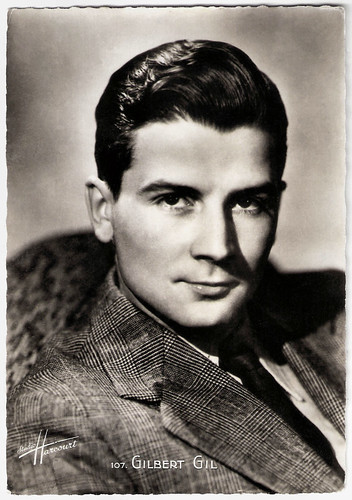
French postcard by S.E.R.P., Paris, no. 107. Photo: Studio Harcourt.
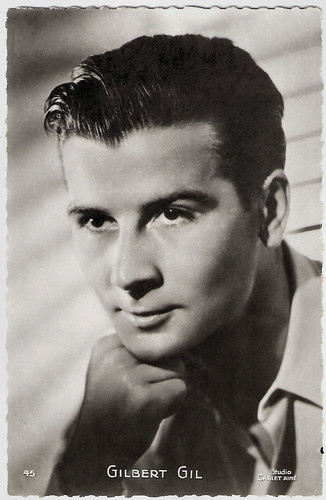
French postcard by Editions P.I., Paris, no. 45. Presented by Biscuits Chocolat Victoria, Bruxelles. Photo: Studio Carlet Ainé.
The handsome young delinquent
Gilbert Jean Alphonse Moreau was born in Goussainville in l913. Soon after Gilbert's birth, his father Jean Moreau left his wife, after which she married his younger brother Jacques. Gilbert grew up within a bourgeois family that owned a large estate, thanks to his grandfather's foundry.
Gil became a handsome young lad, but with the insolence that often comes with it. He often quarrelled with his stepfather and grandfather, and finally moved to Paris. He inscribed at the Conservatoire and set his first steps on stage from 1930, e.g. incarnating a rebellious Arthur Rimbaud in the play 'Verlaine' by Rostand.
In 1935 Gil debuted in cinema as a nameless student in Anatole Litvak's period piece Mayerling (1936), starring Charles Boyer and Danielle Darrieux . Other small parts followed as a young thief, gangster, seducer etc., highlighting his good looks.
A bigger part Gil had as Pierrot, the young friend, acolyte, and protege of Pépé ( Jean Gabin ), the title character of Pépé le Moko (Jules Duvivier, 1937) on a gang leader in Algiers, hunted by the police. When Pierrot is betrayed to the police by informer Régis (Fernand Charpin) and returns to the Casbah, mortally wounded, Pépé takes revenge on Régis.
When Gil first played opposite Pierre Blanchar in the Oscar Wilde adaptation Une femme sans importance/A Woman of No Importance (Jean Choux, 1937), the two so looked alike, that it was rumoured that Blanchar was Gil's father. Raymond Bernard exploited this in his film Le Coupable/Culprit (Raymond Bernard, 1937), in which Gil is a young delinquent involved in murder. The prosecutor ( Pierre Blanchar ) proves to be his father. Two more films with the 'father' and 'son' would follow: Nuit de décembre/Night in December (Kurt Bernhardt, 1940) and Secrets (directed by Pierre Blanchar himself, 1942).
After several minor parts, Gil had a more substantial role in Gribouille/Heart of Paris (Marc Allégret, 1937). Here he is the son of a shopkeeper ( Raimu ) who has taken under his wings a Russian young woman ( Michèle Morgan ), who thanks to his testimony has been acquitted from murder. Father and son both rival for her affections, despite the fact there is still a mother around.
In 1938 Gil joined the French cast and crew of Le voleur des femmes/The Woman Thief (Abel Gance, 1938) travelling to the Pisorno studios in Italy, where the film was shot in both a French and an Italian version. In La Glu (Jean Choux, 1937-1938), Gil was a sailor who falls in love with Marie Bell.
In De Mayerling à Sarajevo/Sarajevo (Max Ophüls, 1940), released just a few days before the Blitzkrieg of the Second World War, Gil played Gavrilo Princip, the Serbian anarchist who killed Austrian crown prince Franz Ferdinand (John Lodge) and his wife Sophie ( Edwige Feuillère ) - the trigger for the outbreak of the First World War.
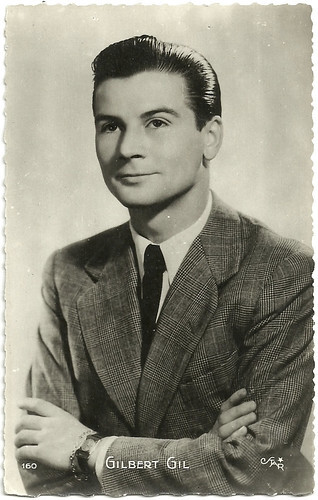
French postcard by Editions P.I., Paris, no. 160. Photo: Star.
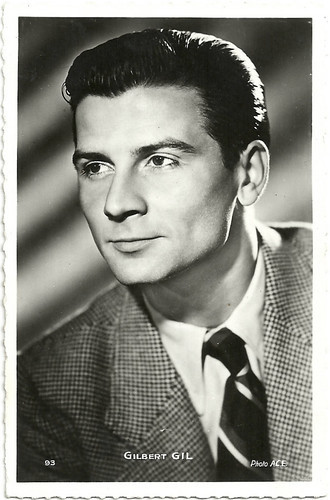
French postcard by Ed. Chantal, Paris, no. 93. Photo: ACE.
Hortensia Bleu
During the war years, Gilbert Gil played e.g. the rebellious son of Jean-Louis Barrault 's Hector Berlioz in La symphonie fantastique/The Fantastic Symphony (Christian-Jaque, 1941). In L'Assassin a peur la nuit/The assassin is afraid at night (Jean Delannoy, 1942), shot at and set in the South of France, Gil played the young worker friend of a thief on the run ( Jean Chévrier ), who tries to become honest and falls in love with his friend's sister ( Louise Carlettti ). Yet, the thief's past haunts him and a former mistress ( Mireille Balin ) pushes him to kill an antiquarian.
In Pierre et Jean/Pierre and Jean (André Cayatte, 1943), based on a novel by Guy de Maupassant, two brothers ( Bernard Lancret and Gil) go through a crisis when they realise they are only half-brothers. Afterward, Gil joined the French actors in the resistance under the pseudonym 'Hortensia Bleu'.
Once the war was over, André Cayatte called him back to play a naive plaything of a femme fatale ( Ginette Leclerc ) in Le dernier sou/The Last Penny (André Cayatte, 1944). After the hardship of the war, comedy was welcomed, so Gil acted in e.g. Leçon de conduit/Lessons in Conduct (Gilles Grangier, 1945) at the end of which a bitch played by Odette Joyeux just doesn't manage to behave well.
In On demande un ménage/We ask for a household (Maurice Cam, 1945) he played the brother of Robert Dhéry, who is disguised as a woman for a practical joke (announcing more of these pranks in subsequent years).
In 1947, Gilbert Gil went behind the camera to direct the crime film Brigade criminelle/Criminal Brigade (Gilbert Gil, 1947). While appearing in front of the camera too, he also introduced Ellen Bersen, his future wife, who would have a short career as an actress. The film, though, was not a huge success and would remain Gil's unique film direction.
Yet, the crime genre fitted him, so he also acted in La dame d'onze heures/The eleven o'clock lady (Jean Devaivre, 1947) with Paul Meurisse , and in Le mannequin assassiné/The Murdered Model (Pierre de Hérain, 1947) with Blanchette Brunoy .
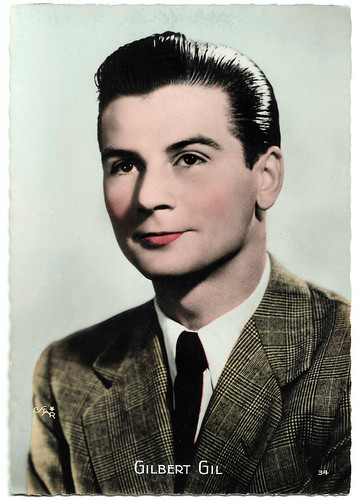
French postcard by Editions O.P., Paris, no. 34. Photo: Star.
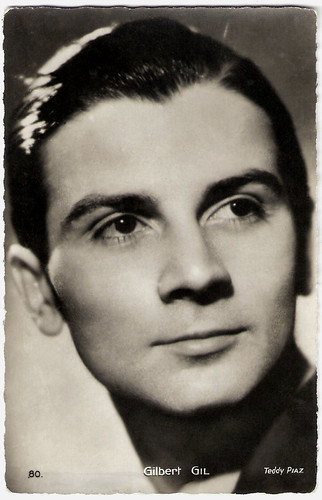
French postcard by Editions O.P., Paris, no. 89. Photo: Teddy Piaz.
A forgotten driving instructor
During the 1950s, Gilbert Gil was as attracted to the city as he was to the scene. He attended many women, which did not prevent him from also being very close to the tandem Jean Cocteau / Jean Marais .
A young father himself, he appeared in Né de père inconnu/Born of Unknown Father (Maurice Cloche, 1950), a melodrama that had to remind him of something. At the same time, he hosted 'Le bar de l'escale', a series of nightly radio programs broadcast on Radio-Tunisie (1953).
Sacha Guitry , who liked him a lot, asked him to play Jean-Jacques Rousseau in Si Versailles m'était conté/Royal Affairs in Versailles (1953), Louis Bonaparte in Napoléon (1954) and Molière in Si Paris nous était conté/If Paris Were Told to Us (1955).
However, the new artistic wave, The Nouvelle Vague, and its competition of a new generation of actors made life harder for Gil. In the early 1960s, he played his last film parts, while he had a last performance in the TV series of Thierry la Fronde (1965).
Gilbert Gil married for the first time with Ellen Bernsen, with whom he had a son who would make a career as a diplomat. After his divorce of Bernsen, Gil remarried with Jeanne Poirson, and finally married for the third time, with Livine Le Tinnier, a notary clerk.
By the mid-1960s, Gilbert Gil, the rebel, was gradually forgotten, and he finally became a driving instructor. A big smoker, Gilbert Gil died of chronic emphysema in 1988, in the retirement home of Maison-Lafitte. His ashes are deposited in the cemetery of La Garenne Colombe.
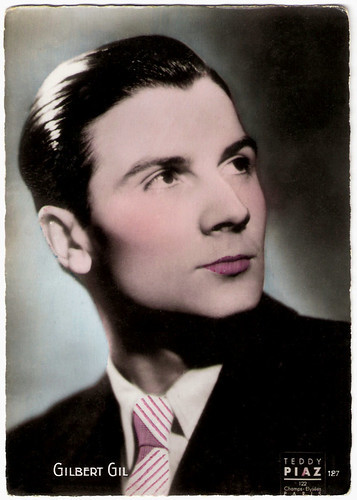
French postcard by Editions O.P., Paris, no. 127. Photo: Teddy Piaz.
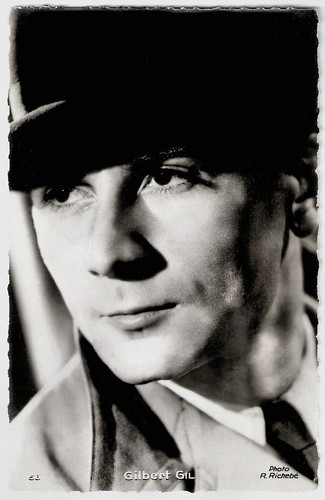
French postcard by Edit. Chantal, Rueil (S.-O.), no. 56. Photo: Roger Richebé.
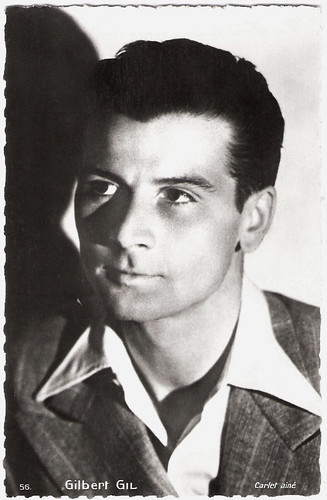
French postcard, no. 56. Photo: Studio Carlet Ainé.
Sources: Donatienne (Encinematheque - French), Wikipedia (French) and

French postcard by S.E.R.P., Paris, no. 107. Photo: Studio Harcourt.

French postcard by Editions P.I., Paris, no. 45. Presented by Biscuits Chocolat Victoria, Bruxelles. Photo: Studio Carlet Ainé.
The handsome young delinquent
Gilbert Jean Alphonse Moreau was born in Goussainville in l913. Soon after Gilbert's birth, his father Jean Moreau left his wife, after which she married his younger brother Jacques. Gilbert grew up within a bourgeois family that owned a large estate, thanks to his grandfather's foundry.
Gil became a handsome young lad, but with the insolence that often comes with it. He often quarrelled with his stepfather and grandfather, and finally moved to Paris. He inscribed at the Conservatoire and set his first steps on stage from 1930, e.g. incarnating a rebellious Arthur Rimbaud in the play 'Verlaine' by Rostand.
In 1935 Gil debuted in cinema as a nameless student in Anatole Litvak's period piece Mayerling (1936), starring Charles Boyer and Danielle Darrieux . Other small parts followed as a young thief, gangster, seducer etc., highlighting his good looks.
A bigger part Gil had as Pierrot, the young friend, acolyte, and protege of Pépé ( Jean Gabin ), the title character of Pépé le Moko (Jules Duvivier, 1937) on a gang leader in Algiers, hunted by the police. When Pierrot is betrayed to the police by informer Régis (Fernand Charpin) and returns to the Casbah, mortally wounded, Pépé takes revenge on Régis.
When Gil first played opposite Pierre Blanchar in the Oscar Wilde adaptation Une femme sans importance/A Woman of No Importance (Jean Choux, 1937), the two so looked alike, that it was rumoured that Blanchar was Gil's father. Raymond Bernard exploited this in his film Le Coupable/Culprit (Raymond Bernard, 1937), in which Gil is a young delinquent involved in murder. The prosecutor ( Pierre Blanchar ) proves to be his father. Two more films with the 'father' and 'son' would follow: Nuit de décembre/Night in December (Kurt Bernhardt, 1940) and Secrets (directed by Pierre Blanchar himself, 1942).
After several minor parts, Gil had a more substantial role in Gribouille/Heart of Paris (Marc Allégret, 1937). Here he is the son of a shopkeeper ( Raimu ) who has taken under his wings a Russian young woman ( Michèle Morgan ), who thanks to his testimony has been acquitted from murder. Father and son both rival for her affections, despite the fact there is still a mother around.
In 1938 Gil joined the French cast and crew of Le voleur des femmes/The Woman Thief (Abel Gance, 1938) travelling to the Pisorno studios in Italy, where the film was shot in both a French and an Italian version. In La Glu (Jean Choux, 1937-1938), Gil was a sailor who falls in love with Marie Bell.
In De Mayerling à Sarajevo/Sarajevo (Max Ophüls, 1940), released just a few days before the Blitzkrieg of the Second World War, Gil played Gavrilo Princip, the Serbian anarchist who killed Austrian crown prince Franz Ferdinand (John Lodge) and his wife Sophie ( Edwige Feuillère ) - the trigger for the outbreak of the First World War.

French postcard by Editions P.I., Paris, no. 160. Photo: Star.

French postcard by Ed. Chantal, Paris, no. 93. Photo: ACE.
Hortensia Bleu
During the war years, Gilbert Gil played e.g. the rebellious son of Jean-Louis Barrault 's Hector Berlioz in La symphonie fantastique/The Fantastic Symphony (Christian-Jaque, 1941). In L'Assassin a peur la nuit/The assassin is afraid at night (Jean Delannoy, 1942), shot at and set in the South of France, Gil played the young worker friend of a thief on the run ( Jean Chévrier ), who tries to become honest and falls in love with his friend's sister ( Louise Carlettti ). Yet, the thief's past haunts him and a former mistress ( Mireille Balin ) pushes him to kill an antiquarian.
In Pierre et Jean/Pierre and Jean (André Cayatte, 1943), based on a novel by Guy de Maupassant, two brothers ( Bernard Lancret and Gil) go through a crisis when they realise they are only half-brothers. Afterward, Gil joined the French actors in the resistance under the pseudonym 'Hortensia Bleu'.
Once the war was over, André Cayatte called him back to play a naive plaything of a femme fatale ( Ginette Leclerc ) in Le dernier sou/The Last Penny (André Cayatte, 1944). After the hardship of the war, comedy was welcomed, so Gil acted in e.g. Leçon de conduit/Lessons in Conduct (Gilles Grangier, 1945) at the end of which a bitch played by Odette Joyeux just doesn't manage to behave well.
In On demande un ménage/We ask for a household (Maurice Cam, 1945) he played the brother of Robert Dhéry, who is disguised as a woman for a practical joke (announcing more of these pranks in subsequent years).
In 1947, Gilbert Gil went behind the camera to direct the crime film Brigade criminelle/Criminal Brigade (Gilbert Gil, 1947). While appearing in front of the camera too, he also introduced Ellen Bersen, his future wife, who would have a short career as an actress. The film, though, was not a huge success and would remain Gil's unique film direction.
Yet, the crime genre fitted him, so he also acted in La dame d'onze heures/The eleven o'clock lady (Jean Devaivre, 1947) with Paul Meurisse , and in Le mannequin assassiné/The Murdered Model (Pierre de Hérain, 1947) with Blanchette Brunoy .

French postcard by Editions O.P., Paris, no. 34. Photo: Star.

French postcard by Editions O.P., Paris, no. 89. Photo: Teddy Piaz.
A forgotten driving instructor
During the 1950s, Gilbert Gil was as attracted to the city as he was to the scene. He attended many women, which did not prevent him from also being very close to the tandem Jean Cocteau / Jean Marais .
A young father himself, he appeared in Né de père inconnu/Born of Unknown Father (Maurice Cloche, 1950), a melodrama that had to remind him of something. At the same time, he hosted 'Le bar de l'escale', a series of nightly radio programs broadcast on Radio-Tunisie (1953).
Sacha Guitry , who liked him a lot, asked him to play Jean-Jacques Rousseau in Si Versailles m'était conté/Royal Affairs in Versailles (1953), Louis Bonaparte in Napoléon (1954) and Molière in Si Paris nous était conté/If Paris Were Told to Us (1955).
However, the new artistic wave, The Nouvelle Vague, and its competition of a new generation of actors made life harder for Gil. In the early 1960s, he played his last film parts, while he had a last performance in the TV series of Thierry la Fronde (1965).
Gilbert Gil married for the first time with Ellen Bernsen, with whom he had a son who would make a career as a diplomat. After his divorce of Bernsen, Gil remarried with Jeanne Poirson, and finally married for the third time, with Livine Le Tinnier, a notary clerk.
By the mid-1960s, Gilbert Gil, the rebel, was gradually forgotten, and he finally became a driving instructor. A big smoker, Gilbert Gil died of chronic emphysema in 1988, in the retirement home of Maison-Lafitte. His ashes are deposited in the cemetery of La Garenne Colombe.

French postcard by Editions O.P., Paris, no. 127. Photo: Teddy Piaz.

French postcard by Edit. Chantal, Rueil (S.-O.), no. 56. Photo: Roger Richebé.

French postcard, no. 56. Photo: Studio Carlet Ainé.
Sources: Donatienne (Encinematheque - French), Wikipedia (French) and
Published on June 05, 2019 22:00
June 4, 2019
Wo ein Wille, ist ein Weg (1918)
German actress, writer and producer Hedda Vernon (1866-?) appeared in more than 60 films of the early silent period. She made the drama Wo ein Wille, ist ein Weg/Where there is a will, there is a way (Hubert Moest, Richard Wilde, 1918) for the Eiko Film studio in Berlin. Rotophot made a series of six sepia cards for the film in the Film Sterne series.
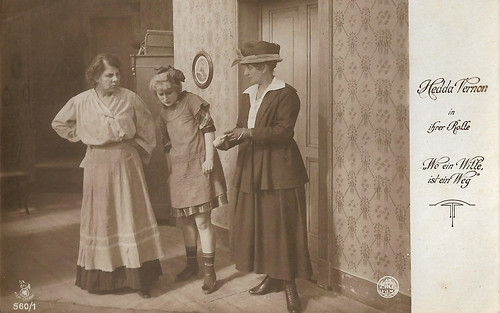
German postcard in the Film Sterne series by Rotophot, no. 560/1. Photo: Eiko Film. Hedda Vernon in Wo ein Wille, ist ein Weg (Hubert Moest, Richard Wilde, 1918).
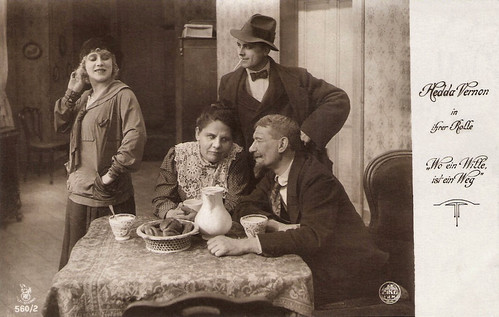
German postcard in the Film Sterne Series by Rotophot, no. 560/2. Photo: Eiko Film. Hedda Vernon in Wo ein Wille, ist ein Weg (Hubert Moest, Richard Wilde, 1918) with right back Ernst Hofmann .
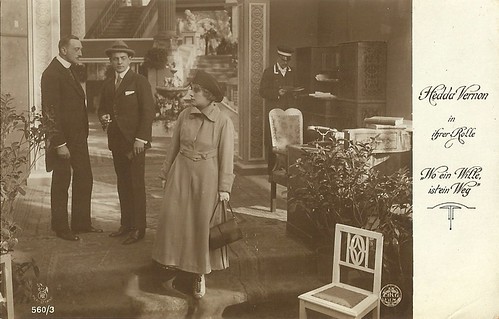
German postcard in the Film Sterne series by Rotophot, no. 560/3. Photo: Eiko Film. Hedda Vernon in Wo ein Wille, ist ein Weg (Hubert Moest, Richard Wilde, 1918).
The girl from a shady inn
In Wo ein Wille, ist ein Weg/Where there is a will, there is a way (Hubert Moest, Richard Wilde, 1918), Hedda Vernon plays Gerda, a girl from a shady inn.
Gerda is surrounded by evil people, but she experiences goodness, betters her life and manages to marry well.
The film was scripted by Richard Wilde, and based on a story by Richard Skowronnek. Wilde codirected the film with Hubert Moest, Vernon's then-husband, who directed her in dozens of films in the later 1910s.
In addition to Vernon, the other main actors were Ernst Hofmann (Heinz), Olga Engl, Marie von Bülow, Kurt Walden, and Ernst Gross. Wo ein Wille, ist ein Weg premiered in November 1918 at the Berlin Tauentzien Palast.
Wo ein Wille, ist ein Weg was censored in Germany as not permitted to juveniles. As the postcards show the film's plot contained theft by children and adults alike, this may have been the cause.
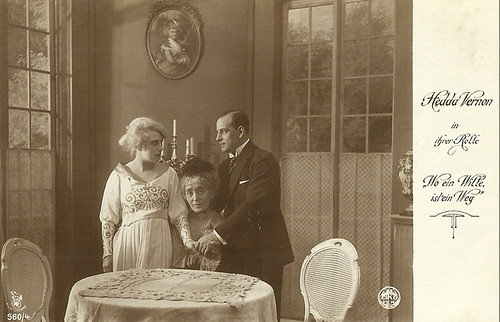
German postcard in the Film Sterne series by Rotophot, no. 560/4. Photo: Eiko Film. Hedda Vernon in Wo ein Wille, ist ein Weg (Hubert Moest, Richard Wilde, 1918). The seated woman is Olga Engl, the man could be Kurt Walden or Ernst Gross.
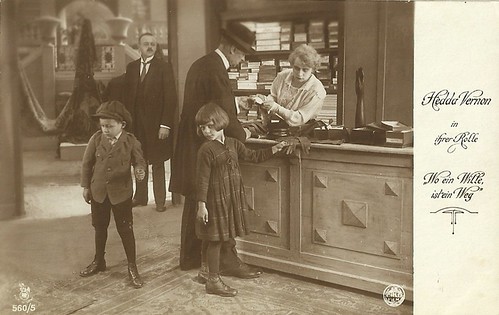
German postcard in the Film Sterne series by Rotophot, no. 560/5. Photo: Eiko Film. Hedda Vernon in Wo ein Wille, ist ein Weg (Hubert Moest, Richard Wilde, 1918).
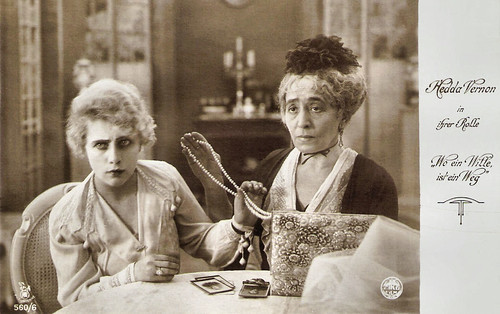
German postcard by Rotophot in the Film-Sterne series, no. 560/6. Photo: Eiko Film. Hedda Vernon in Wo ein Wille, ist ein Weg (Hubert Moest, Richard Wilde, 1918). The woman on the right is Olga Engl.
Sources: The German Early Cinema Database, Filmportal.de and IMDb.

German postcard in the Film Sterne series by Rotophot, no. 560/1. Photo: Eiko Film. Hedda Vernon in Wo ein Wille, ist ein Weg (Hubert Moest, Richard Wilde, 1918).

German postcard in the Film Sterne Series by Rotophot, no. 560/2. Photo: Eiko Film. Hedda Vernon in Wo ein Wille, ist ein Weg (Hubert Moest, Richard Wilde, 1918) with right back Ernst Hofmann .

German postcard in the Film Sterne series by Rotophot, no. 560/3. Photo: Eiko Film. Hedda Vernon in Wo ein Wille, ist ein Weg (Hubert Moest, Richard Wilde, 1918).
The girl from a shady inn
In Wo ein Wille, ist ein Weg/Where there is a will, there is a way (Hubert Moest, Richard Wilde, 1918), Hedda Vernon plays Gerda, a girl from a shady inn.
Gerda is surrounded by evil people, but she experiences goodness, betters her life and manages to marry well.
The film was scripted by Richard Wilde, and based on a story by Richard Skowronnek. Wilde codirected the film with Hubert Moest, Vernon's then-husband, who directed her in dozens of films in the later 1910s.
In addition to Vernon, the other main actors were Ernst Hofmann (Heinz), Olga Engl, Marie von Bülow, Kurt Walden, and Ernst Gross. Wo ein Wille, ist ein Weg premiered in November 1918 at the Berlin Tauentzien Palast.
Wo ein Wille, ist ein Weg was censored in Germany as not permitted to juveniles. As the postcards show the film's plot contained theft by children and adults alike, this may have been the cause.

German postcard in the Film Sterne series by Rotophot, no. 560/4. Photo: Eiko Film. Hedda Vernon in Wo ein Wille, ist ein Weg (Hubert Moest, Richard Wilde, 1918). The seated woman is Olga Engl, the man could be Kurt Walden or Ernst Gross.

German postcard in the Film Sterne series by Rotophot, no. 560/5. Photo: Eiko Film. Hedda Vernon in Wo ein Wille, ist ein Weg (Hubert Moest, Richard Wilde, 1918).

German postcard by Rotophot in the Film-Sterne series, no. 560/6. Photo: Eiko Film. Hedda Vernon in Wo ein Wille, ist ein Weg (Hubert Moest, Richard Wilde, 1918). The woman on the right is Olga Engl.
Sources: The German Early Cinema Database, Filmportal.de and IMDb.
Published on June 04, 2019 22:00
June 3, 2019
Ermete Novelli
Ermete Novelli (1851-1919) was a legendary monstre sacré of the Italian theatre. When the famous actor and playwright appeared in films of the Film d'Arte Italiana, the press condemned his theatrical performances on screen. But with later films he got even.
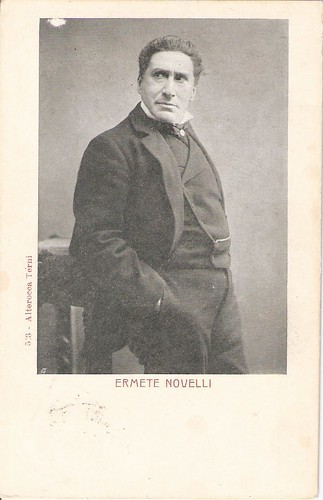
Italian postcard by Alterocca, Terni, no. 513.
Virgilio Alterocca (1853-1910) founded the first company for illustrated and photographic cards in Italy. He already started a typographic company in 1877 working for newspapers and producing posters, but around 1896, thanks to modernising techniques in phototypography from Germany and Switzerland, he was able to make photographic cards a booming business.
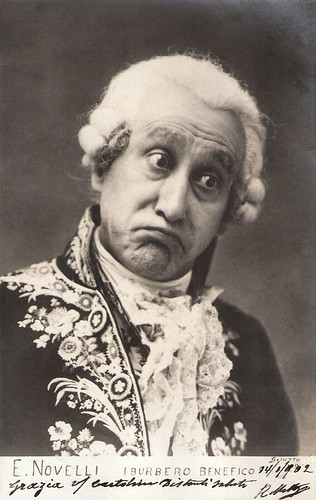
Italian postcard. Sent by mail in 1902. Photo: Sciotto. Ermete Novelli as/in Burbero Benefico.
Monstre Sacré
Ermete Novelli was born in 1851 in Lucca, Tuscany. His father was a prompter and he came from a noble and ancient family from Bertinoro.
Already at an early age, in 1866, he started to act on stage and soon he became one of the 'monstres sacrés' of the Italian stage of the 1870s and 1880s.
In 1885 he founded his own company and had triumphs in Paris in 1898 and 1902. He also performed in New York in 1907 as Antony Novelli.
Inspired by the Comédie Française, he founded in 1900 his own 'teatro stabile', Casa Goldoni, at the Teatro Valle in Rome. In the 1910s he lead the company Fert, to which such actors as Lyda Borelli were attached. Together they did a.o. Sem Benelli's play Le nozze dei centauri (1915) at the Teatro Manzoni in Milan and elsewhere.
On his own or in collaboration, Novelli also wrote several comedies and monologues. Rimini has a Teatro Ermete Novelli and Italy knows since 2002 the Premio Ermete Novelli for the best stage actor.
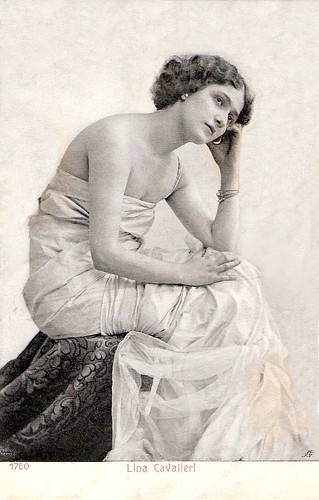
Italian soprano Lina Cavalieri . Italian postcard by Alterocca, Terni, no. 1750.
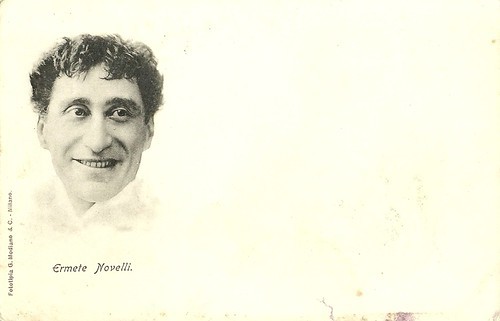
Italian postcard by Fototipia G. Modiano & C., Milano.
Film d'Arte Italiana
Just a few years after the film d'art phenomenon had spread in France, Ermete Novelli started to act in film too, from Shakespearian costume dramas as Re Lear/King Lear (Gerolamo Lo Savio, 1910) and Il Mercante di Venezia/The Merchant of Venice (Gerolamo Lo Savio, 1910) to La Morte Civile/The civil death (Gerolamo Lo Savio, 1910), based on the Italian play by Paolo Giacometti.
These short, silent films were directed by Gerolamo Lo Savio for the Film d'Arte Italiana, a subsidiary of Pathé Frères. All the films were shot in Rimini, where Novelli had his villa, and partly in Venice (The Merchant of Venice).
There were high expectations about seeing Novelli on screen, but the film press condemned the films because of Novelli's theatrical performance. He neglected the new medium and did not take film seriously at all.
A few years later, another star of the Italian stage, Eleonora Duse , better understood that cinema was a different medium.
In the films by Lo Savio, a new young actress performed opposite Novelli: Francesca Bertini . Though she had had some stage training, she was a real film actress and soon she would become one of the divas of the Italian cinema. A greater contrast to Novelli was unimaginable.
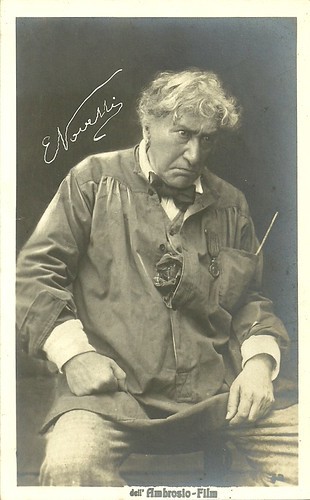
Italian postcard. Photo: Ambrosio-Film.
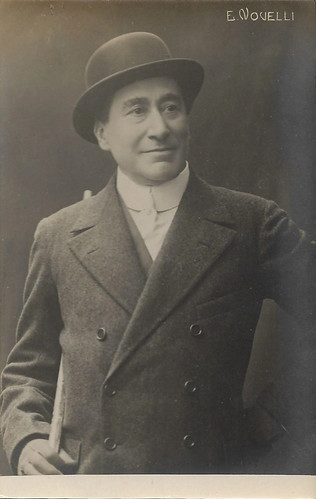
Italian postcard by Tensi.
Elettra Raggio
A few years later, Ermete Novelli tried his luck in the cinema again. He returned to the screen, now for the production company Ambrosio .
The films were based on French pochades which Novelli had successfully performed on stage: Michele Perrin/Michael Perrine (Eleuterio Rodolfi, 1913) and La gerla di Papa Martin/Honour Thy Father (Eleuterio Rodolfi, 1914), both opposite Gigetta Morano, the regular Ambrosio comedienne.
This time, the press was much more favourable. In 1915, Novelli acted in - unsuccessful and hardly noticed - films by his son, writer-director Enrico Novelli: the comedy Fiorenza mia!/My Florence! and the drama Il più grande amore/The Greatest Love.
They were followed by the war propaganda film Per la Patria!/For the Motherland! (Ugo Falena, 1915).
Towards the end of the war Novelli played in two remarkable films, Automartirio/Selfmartyrdom (Ivo Illuminati, 1917) and La morte che assolve/The death that performs (Alberto Carlo Lolli, 1918), both starring the Milanese star Elettra Raggio, who was also the producer of these two films.
While of the latter film a copy has been found and restored - and thus we can admire both Novelli and Raggio as the father and daughter of the story - of the former only the beautiful posters exist.
In 1919, Ermete Novelli died in Naples, Italy (according to Wikipedia ) or Paris, France (according to IMDb ). Wikipedia adds that he was "survived by at least one child, his son, Enrico 'Yambo' Novelli." He was 67.
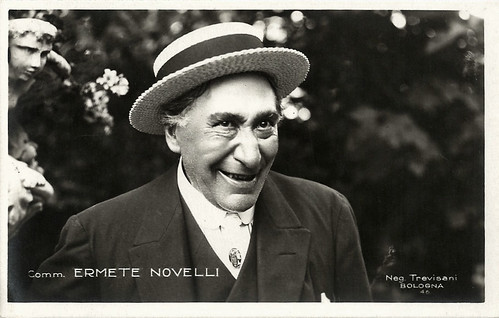
Italian postcard by Ed. Vettori, Bologna, no. 46. Photo: Trevisani, Bologna.
Re Lear/King Lear (Gerolamo Lo Savio, 1910). Source: Change Before Going Productions (YouTube).
Il Mercante di Venezia/The Merchant of Venice (Gerolamo Lo Savio, 1910). Source: Carla Marinho (YouTube).
Sources: Wikipedia, Del Teatro (Italian), and .

Italian postcard by Alterocca, Terni, no. 513.
Virgilio Alterocca (1853-1910) founded the first company for illustrated and photographic cards in Italy. He already started a typographic company in 1877 working for newspapers and producing posters, but around 1896, thanks to modernising techniques in phototypography from Germany and Switzerland, he was able to make photographic cards a booming business.

Italian postcard. Sent by mail in 1902. Photo: Sciotto. Ermete Novelli as/in Burbero Benefico.
Monstre Sacré
Ermete Novelli was born in 1851 in Lucca, Tuscany. His father was a prompter and he came from a noble and ancient family from Bertinoro.
Already at an early age, in 1866, he started to act on stage and soon he became one of the 'monstres sacrés' of the Italian stage of the 1870s and 1880s.
In 1885 he founded his own company and had triumphs in Paris in 1898 and 1902. He also performed in New York in 1907 as Antony Novelli.
Inspired by the Comédie Française, he founded in 1900 his own 'teatro stabile', Casa Goldoni, at the Teatro Valle in Rome. In the 1910s he lead the company Fert, to which such actors as Lyda Borelli were attached. Together they did a.o. Sem Benelli's play Le nozze dei centauri (1915) at the Teatro Manzoni in Milan and elsewhere.
On his own or in collaboration, Novelli also wrote several comedies and monologues. Rimini has a Teatro Ermete Novelli and Italy knows since 2002 the Premio Ermete Novelli for the best stage actor.

Italian soprano Lina Cavalieri . Italian postcard by Alterocca, Terni, no. 1750.

Italian postcard by Fototipia G. Modiano & C., Milano.
Film d'Arte Italiana
Just a few years after the film d'art phenomenon had spread in France, Ermete Novelli started to act in film too, from Shakespearian costume dramas as Re Lear/King Lear (Gerolamo Lo Savio, 1910) and Il Mercante di Venezia/The Merchant of Venice (Gerolamo Lo Savio, 1910) to La Morte Civile/The civil death (Gerolamo Lo Savio, 1910), based on the Italian play by Paolo Giacometti.
These short, silent films were directed by Gerolamo Lo Savio for the Film d'Arte Italiana, a subsidiary of Pathé Frères. All the films were shot in Rimini, where Novelli had his villa, and partly in Venice (The Merchant of Venice).
There were high expectations about seeing Novelli on screen, but the film press condemned the films because of Novelli's theatrical performance. He neglected the new medium and did not take film seriously at all.
A few years later, another star of the Italian stage, Eleonora Duse , better understood that cinema was a different medium.
In the films by Lo Savio, a new young actress performed opposite Novelli: Francesca Bertini . Though she had had some stage training, she was a real film actress and soon she would become one of the divas of the Italian cinema. A greater contrast to Novelli was unimaginable.

Italian postcard. Photo: Ambrosio-Film.

Italian postcard by Tensi.
Elettra Raggio
A few years later, Ermete Novelli tried his luck in the cinema again. He returned to the screen, now for the production company Ambrosio .
The films were based on French pochades which Novelli had successfully performed on stage: Michele Perrin/Michael Perrine (Eleuterio Rodolfi, 1913) and La gerla di Papa Martin/Honour Thy Father (Eleuterio Rodolfi, 1914), both opposite Gigetta Morano, the regular Ambrosio comedienne.
This time, the press was much more favourable. In 1915, Novelli acted in - unsuccessful and hardly noticed - films by his son, writer-director Enrico Novelli: the comedy Fiorenza mia!/My Florence! and the drama Il più grande amore/The Greatest Love.
They were followed by the war propaganda film Per la Patria!/For the Motherland! (Ugo Falena, 1915).
Towards the end of the war Novelli played in two remarkable films, Automartirio/Selfmartyrdom (Ivo Illuminati, 1917) and La morte che assolve/The death that performs (Alberto Carlo Lolli, 1918), both starring the Milanese star Elettra Raggio, who was also the producer of these two films.
While of the latter film a copy has been found and restored - and thus we can admire both Novelli and Raggio as the father and daughter of the story - of the former only the beautiful posters exist.
In 1919, Ermete Novelli died in Naples, Italy (according to Wikipedia ) or Paris, France (according to IMDb ). Wikipedia adds that he was "survived by at least one child, his son, Enrico 'Yambo' Novelli." He was 67.

Italian postcard by Ed. Vettori, Bologna, no. 46. Photo: Trevisani, Bologna.
Re Lear/King Lear (Gerolamo Lo Savio, 1910). Source: Change Before Going Productions (YouTube).
Il Mercante di Venezia/The Merchant of Venice (Gerolamo Lo Savio, 1910). Source: Carla Marinho (YouTube).
Sources: Wikipedia, Del Teatro (Italian), and .
Published on June 03, 2019 22:00
June 2, 2019
Gail Russell
American actress Gail Russell (1924-1961) was an incredible doe-eyed beauty who presented a screen image of great innocence and vulnerability. She is best known for the supernatural horror film The Uninvited (1944). During a promising career at Paramount, she became a victim of alcoholism. It ruined her career, appearance and marriage to Guy Madison. In 1961, she died from liver damage, only 36.
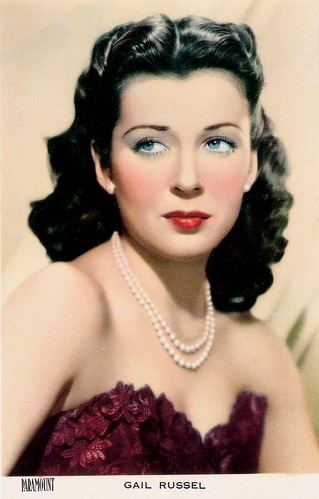
Belgian postcard by N.V. Victoria, Brussels, no. 639 / 21. Photo: Paramount.
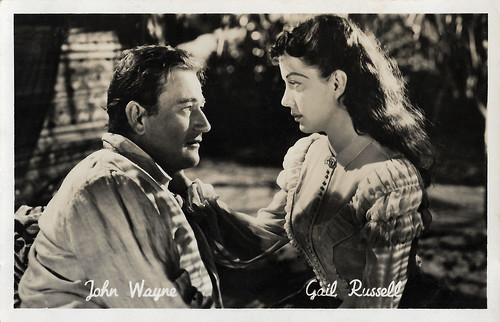
Belgian postcard by Nieuwe Merkemsche Chocolaterie S.P.R.L., Merksem. Photo: Republic Pictures. John Wayne and Gail Russell in Wake of The Red Witch (1948).
Haunting, melancholy beauty
Gail Russell was born born Elizabeth L. Russell in 1924 to George and Gladys (Barnet) Russell in Chicago, Illinois. The family moved to the Los Angeles, California, area when she was a teenager. Her father was initially a musician but later worked for Lockheed Corporation.
Russell attended high school in Santa Monica, California, where she was spotted by a Paramount talent scout and signed to a contract immediately upon graduation. Although Russell was possessed with a paralysing kind of self-consciousness and had no acting experience, Paramount had great expectations for her and employed an acting coach to work with her.
At the age of 19 she made her film debut with a small part in the comedy Henry Aldrich Gets Glamour (Hugh Bennett, 1943). She also had a small part in the musical Lady in the Dark (Mitchell Leisen, 1943) with Ginger Rogers.
Russell's haunting, melancholy beauty was ideally suited for the ingenue role in the lavish supernatural horror film The Uninvited (Lewis Allen, 1944) with Ray Milland . Hal Erickson at AllMovie : "The Uninvited remains one of the spookiest 'old dark house' films ever made, even after years of inundation by computer-generated special effects."
Lewis Allen then directed Russell in Our Hearts Were Young and Gay (Lewis Allen, 1944), in which she co-starred with Diana Lynn. It was another success. Russell co-starred opposite Alan Ladd in Salty O'Rourke (Raoul Walsh, 1945), a horse racing drama. She made a third film with Allen, The Unseen (Lewis Allen, 1945), an unofficial follow up to The Uninvited. Gail played Elizabeth Howard, a governess of the house in question. The film turned a profit but was not the hit that Paramount executives hoped for.
Then she and Diana Lynn were in Our Hearts Were Growing Up (William D. Russell, 1946), a sequel to Our Hearts Were Young and Gay. The plot centred around two young college girls getting involved with bootleggers. Unfortunately, it was not anywhere the calibre of the first film and it failed at the box-office. She was reunited with Ladd in Calcutta (John Farrow, 1947), shot in 1945 but not released until two years later. Although the film was popular, critics felt that Russell was miscast.
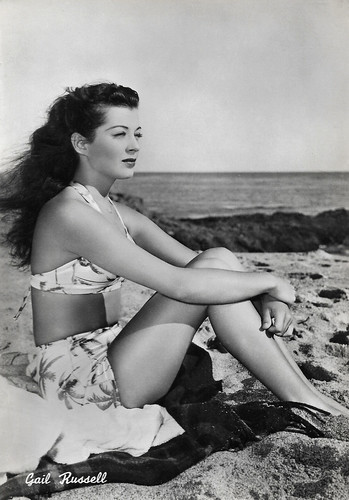
Italian postcard by Bromofoto, Milano, no. 233.
A victim of alcoholism
Gail Russell left Paramount and appeared in the romantic comedy The Bachelor's Daughters (Andrew L. Stone, 1948) for United Artists. John Wayne hired her to be his co-star in a film he was producing, Angel and the Badman (James Edward Grant, 1948). It was a hit with the public and Gail shone in the role of Penelope Worth, a feisty Quaker girl who tries to tame gunfighter Wayne.
She did Moonrise (Frank Borzage, 1948) for Republic. Bruce Eder at AllMovie : "Moonrise, the most expensive movie ever made by Republic up to that time, but one that was worth every penny. Arguably Borzage's finest directorial effort and the most hauntingly beautiful movie ever issued by the studio, Moonrise is filled with delights at just about every level that it is possible to enjoy in a movie."
Russell returned to Paramount for Night Has a Thousand Eyes (John Farrow, 1948) with Edward G. Robinson, then reteamed with John Wayne for Wake of the Red Witch (Edward Ludwig, 1948). She appeared again with Wayne in a Western for Pine-Thomas Productions, El Paso (Lewis R. Foster, 1949).
Russell then did Song of India (Albert S. Rogell, 1949) with Sabu for Columbia, and The Great Dan Patch (Joseph M. Newman, 1949) with Dennis O'Keefe for United Artists. She made some more Pine-Thomas films: Captain China (Lewis R. Foster, 1950) with John Payne, and the Film Noir The Lawless (Joseph Losey, 1951) with Macdonald Carey.
Russell married film star Guy Madison in 1949, but by 1950 it was well known that she had become a victim of alcoholism, and Paramount did not renew her contract. She had started drinking on the set of The Uninvited to ease her paralysing stage fright and lack of confidence.
She made Air Cadet (Joseph Pevney, 1951) for Universal, but alcohol made a shambles of her career, appearance and personal life. In January 1954, in a court in Santa Monica, California, Russell pleaded guilty to a charge of drunkenness, receiving a $150 fine. The fine was in lieu of a jail sentence, with the provision that she not use intoxicants or attend night spots for two years. In the same court session, she received a continuance on a charge of driving while drunk.
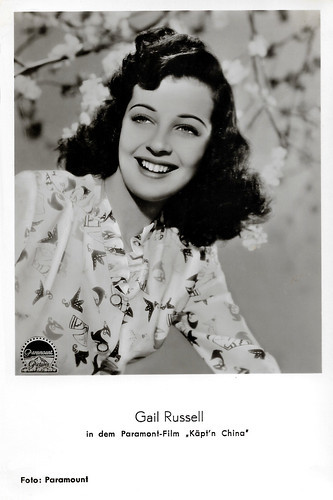
German postcard by F.J. Rüdel. Filmpostkartenverlag, Hamburg-Bergedorf, no. 217. Photo: Paramount. Gail Russell in Captain China (Lewis R. Foster, 1950).

German postcard by Kolibri-Verlag, Minden/Westf. Photo: Republic Pictures / Gloria Filmverleih.
Attempting to get control of her life
Gail Russell disappeared from the screen for the next five years while she attempted to get control of her life. In 1954, she divorced Guy Madison . She returned to work in a co-starring role with Randolph Scott in the Western Seven Men from Now (Budd Boetticher, 1956), produced by her friend John Wayne, and had a substantial role in the Film Noir The Tattered Dress (Jack Arnold, 1957) with Jeanne Crain and Jeff Chandler.
In July 1957, she was photographed by a Los Angeles Times photographer after she drove her convertible into the front of Jan's Coffee Shop at 8424 Beverly Boulevard. After failing a sobriety test, Russell was arrested and charged with driving under the influence. She appeared in the B-film No Place to Land (Albert C. Gannaway, 1958) for Republic. By now the demons of alcohol had her in its grasp.
She was again absent from the screen until The Silent Call (John A. Bushelman, 1961), a respectable family film about a big dog by the name of Pete with definite separation anxiety. It was to be her last film.
On 26 August 1961, Russell was found dead in her small apartment in Brentwood, Los Angeles, California. She was only 36. She died from liver damage attributed to "acute and chronic alcoholism" with stomach contents aspiration as an additional cause. She was also found to have been suffering from malnutrition at the time of her death. She was buried in Valhalla Memorial Park Cemetery in North Hollywood.
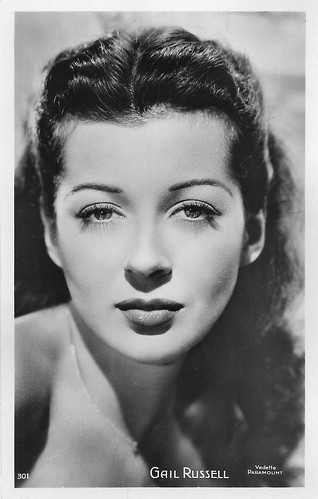
French postcard, no. 301. Photo: Paramount.
Sources: Hal Erickson (AllMovie), (IMDb), (IMDb), Wikipedia and .

Belgian postcard by N.V. Victoria, Brussels, no. 639 / 21. Photo: Paramount.

Belgian postcard by Nieuwe Merkemsche Chocolaterie S.P.R.L., Merksem. Photo: Republic Pictures. John Wayne and Gail Russell in Wake of The Red Witch (1948).
Haunting, melancholy beauty
Gail Russell was born born Elizabeth L. Russell in 1924 to George and Gladys (Barnet) Russell in Chicago, Illinois. The family moved to the Los Angeles, California, area when she was a teenager. Her father was initially a musician but later worked for Lockheed Corporation.
Russell attended high school in Santa Monica, California, where she was spotted by a Paramount talent scout and signed to a contract immediately upon graduation. Although Russell was possessed with a paralysing kind of self-consciousness and had no acting experience, Paramount had great expectations for her and employed an acting coach to work with her.
At the age of 19 she made her film debut with a small part in the comedy Henry Aldrich Gets Glamour (Hugh Bennett, 1943). She also had a small part in the musical Lady in the Dark (Mitchell Leisen, 1943) with Ginger Rogers.
Russell's haunting, melancholy beauty was ideally suited for the ingenue role in the lavish supernatural horror film The Uninvited (Lewis Allen, 1944) with Ray Milland . Hal Erickson at AllMovie : "The Uninvited remains one of the spookiest 'old dark house' films ever made, even after years of inundation by computer-generated special effects."
Lewis Allen then directed Russell in Our Hearts Were Young and Gay (Lewis Allen, 1944), in which she co-starred with Diana Lynn. It was another success. Russell co-starred opposite Alan Ladd in Salty O'Rourke (Raoul Walsh, 1945), a horse racing drama. She made a third film with Allen, The Unseen (Lewis Allen, 1945), an unofficial follow up to The Uninvited. Gail played Elizabeth Howard, a governess of the house in question. The film turned a profit but was not the hit that Paramount executives hoped for.
Then she and Diana Lynn were in Our Hearts Were Growing Up (William D. Russell, 1946), a sequel to Our Hearts Were Young and Gay. The plot centred around two young college girls getting involved with bootleggers. Unfortunately, it was not anywhere the calibre of the first film and it failed at the box-office. She was reunited with Ladd in Calcutta (John Farrow, 1947), shot in 1945 but not released until two years later. Although the film was popular, critics felt that Russell was miscast.

Italian postcard by Bromofoto, Milano, no. 233.
A victim of alcoholism
Gail Russell left Paramount and appeared in the romantic comedy The Bachelor's Daughters (Andrew L. Stone, 1948) for United Artists. John Wayne hired her to be his co-star in a film he was producing, Angel and the Badman (James Edward Grant, 1948). It was a hit with the public and Gail shone in the role of Penelope Worth, a feisty Quaker girl who tries to tame gunfighter Wayne.
She did Moonrise (Frank Borzage, 1948) for Republic. Bruce Eder at AllMovie : "Moonrise, the most expensive movie ever made by Republic up to that time, but one that was worth every penny. Arguably Borzage's finest directorial effort and the most hauntingly beautiful movie ever issued by the studio, Moonrise is filled with delights at just about every level that it is possible to enjoy in a movie."
Russell returned to Paramount for Night Has a Thousand Eyes (John Farrow, 1948) with Edward G. Robinson, then reteamed with John Wayne for Wake of the Red Witch (Edward Ludwig, 1948). She appeared again with Wayne in a Western for Pine-Thomas Productions, El Paso (Lewis R. Foster, 1949).
Russell then did Song of India (Albert S. Rogell, 1949) with Sabu for Columbia, and The Great Dan Patch (Joseph M. Newman, 1949) with Dennis O'Keefe for United Artists. She made some more Pine-Thomas films: Captain China (Lewis R. Foster, 1950) with John Payne, and the Film Noir The Lawless (Joseph Losey, 1951) with Macdonald Carey.
Russell married film star Guy Madison in 1949, but by 1950 it was well known that she had become a victim of alcoholism, and Paramount did not renew her contract. She had started drinking on the set of The Uninvited to ease her paralysing stage fright and lack of confidence.
She made Air Cadet (Joseph Pevney, 1951) for Universal, but alcohol made a shambles of her career, appearance and personal life. In January 1954, in a court in Santa Monica, California, Russell pleaded guilty to a charge of drunkenness, receiving a $150 fine. The fine was in lieu of a jail sentence, with the provision that she not use intoxicants or attend night spots for two years. In the same court session, she received a continuance on a charge of driving while drunk.

German postcard by F.J. Rüdel. Filmpostkartenverlag, Hamburg-Bergedorf, no. 217. Photo: Paramount. Gail Russell in Captain China (Lewis R. Foster, 1950).

German postcard by Kolibri-Verlag, Minden/Westf. Photo: Republic Pictures / Gloria Filmverleih.
Attempting to get control of her life
Gail Russell disappeared from the screen for the next five years while she attempted to get control of her life. In 1954, she divorced Guy Madison . She returned to work in a co-starring role with Randolph Scott in the Western Seven Men from Now (Budd Boetticher, 1956), produced by her friend John Wayne, and had a substantial role in the Film Noir The Tattered Dress (Jack Arnold, 1957) with Jeanne Crain and Jeff Chandler.
In July 1957, she was photographed by a Los Angeles Times photographer after she drove her convertible into the front of Jan's Coffee Shop at 8424 Beverly Boulevard. After failing a sobriety test, Russell was arrested and charged with driving under the influence. She appeared in the B-film No Place to Land (Albert C. Gannaway, 1958) for Republic. By now the demons of alcohol had her in its grasp.
She was again absent from the screen until The Silent Call (John A. Bushelman, 1961), a respectable family film about a big dog by the name of Pete with definite separation anxiety. It was to be her last film.
On 26 August 1961, Russell was found dead in her small apartment in Brentwood, Los Angeles, California. She was only 36. She died from liver damage attributed to "acute and chronic alcoholism" with stomach contents aspiration as an additional cause. She was also found to have been suffering from malnutrition at the time of her death. She was buried in Valhalla Memorial Park Cemetery in North Hollywood.

French postcard, no. 301. Photo: Paramount.
Sources: Hal Erickson (AllMovie), (IMDb), (IMDb), Wikipedia and .
Published on June 02, 2019 22:00
June 1, 2019
George Walsh
George Walsh (1889-1981) was an American film actor, who despite a successful career in silent cinema is best remembered for the loss of the part of a lifetime: the title role in Ben-Hur (1925).

British postcard in the Cinema Stars series by Lilywhite Ltd., no. CM 411 C. Photo: Fox.
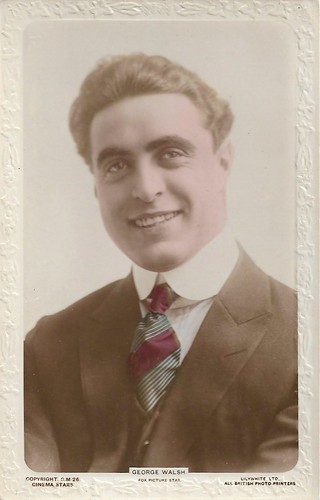
British postcard in the Cinema Stars series by Lilywhite Ltd., no. G.M. 26. Photo: Fox.
A fierce rival to Douglas Fairbanks as a daredevil
George Frederick Walsh was born in New York in 1889 to Catholic parents of Irish descent. He was the middle child of three siblings and his older brother was the later film director, Raoul Walsh. In 1911, he graduated from the High School of Commerce, where he excelled in sports such as baseball and swimming. Later, he also attended the Fordham and Georgetown University.
He followed his brother Raoul to Hollywood, where he made his first films in 1915, including a bit part in D.W. Griffith's controversial epic The Birth of a Nation (1915). Various bit parts followed, until a small role in The Fencing Master (Raoul Walsh, 1915) proved he was capable. Griffith gave him a bigger part as the bridegroom at the wedding of Kana in Intolerance (D.W. Griffith, 1916).
In the following years, the dark-haired, handsome Walsh established himself as a popular leading actor, both in comedies and in adventure films. In 1919 he also directed The Seventh Person with himself in the lead role, but it remained his only film direction.
At the Fox Film Studios between ca. 1916 and 1920, Walsh starred in a large series of fast-paced comedies highlighted by athletic stunt work, by which he became a fierce rival to Douglas Fairbanks as a daredevil, who combined stunts with comic relief. Walsh's good looks made him a heartthrob in the Francis X. Bushman-Wallace Reid tradition. Most of Walsh's successful films at Fox were later destroyed by a fire at Fox in 1937 and thus have disappeared today. Many of these were directed by Walsh' brother Raoul.
In 1920 Walsh had a conflict with Fox about his salary. He turned down a renewal of his Fox contract in 1921 which would have raised his salary from $1500 to $2000 a week in 1921. He felt he deserved more as his pictures always showed a profit while the films of Pearl White, who was making $4000 per week, were financial losers for the studio. He left the studio.
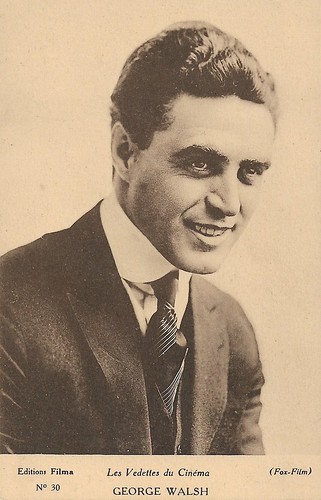
French postcard in the Les Vedettes du Cinéma series by Editions Filma, bo. 30. Photo: Fox-Film.
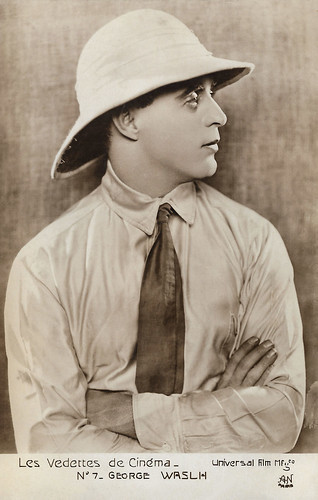
French postcard in the Les Vedettes de Cinéma series by A.N., Paris, no. 7. Photo: Universal Film Manufactoring Co. George Walsh in With Stanley in Africa (William James Craft, Edward A. Kull, 1922).
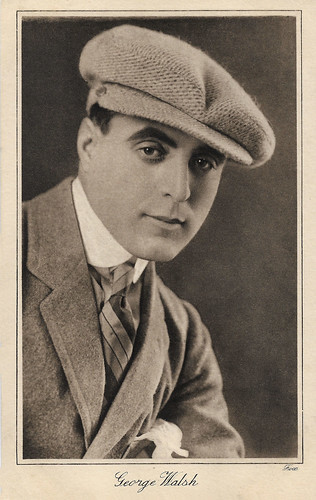
British postcard. Photo: Fox.
Unceremoniously replaced
After two years of ups and downs, George Walsh got a contract at Goldwyn Pictures. This single-picture deal Vanity Fair (Hugo Ballin, 1923) led to a long contract and a quick shift from supporting characters to leads. He got his confirmation as Goldwyn star, when Walsh was directed by Ernst Lubitsch as the partner of Mary Pickford in Rosita (Ernst Lubitsch, 1923). As the charming Don Diego, he defends Pickford's rebellious Rosita but soon ends up in prison himself, destined to be hanged. The perfidious King (Holbrook Blinn) arranges a mock marriage before Diego will be hanged, but in the end, the Queen (Irene Rich) saves the situation and Diego's life.
Even more spectacular was Walsh selection by scriptwriter June Mathis for the title role in the super production Ben-Hur, produced by Goldwyn. Walsh had already shot the film halfway with director Charles Brabin in Italy - despite a wide range of problems - when Spring 1924 Goldwyn merged with Metro (the future MGM). The new management unceremoniously replaced Brabin by Fred Niblo and Walsh by rising star Ramon Novarro .
Walsh was not told and discovered it while still in Europe when co-star Francis X. Bushman read it to him from a newspaper headline. George was soon on his way back to the United States. The newly formed MGM did little to combat rumours he had not been up to standard. Until the end of his life, the losing of the role of Ben-Hur was a sensitive subject of discussion for Walsh.
After that, Walsh continued acting but at the independent company Chadwick Pictures and the even more low budget company Excellent Pictures. It was not until 1932 when he started to do his first talking picture: Me and My Pal (Raoul Walsh, 1932) alongside Spencer Tracy and Joan Bennett. Walsh played a sleazy mobster who eyes a naive girl, but her sister (Bennett) and her friend, a cop (Tracy), save her from his clutches. Walsh continued to play supporting parts and bit parts until 1936. After about 80 films, Walsh retired in 1936. His retirement was triggered by the fact he was approaching fifty and was no longer in good shape.
George Walsh love thoroughbred horses and managed the numerous horses of his brother, who were bred and raced on racecourses. This had also been his occupation between silents and talkies. Walsh was married to the actress Seena Owen (1894-1966) from 1916 to 1924, the marriage was divorced. In 1981, seven months after the death of his brother Raoul, George Walsh died of pneumonia in Pomona, California, at the age of 92 years. He was buried at the San Gabriel Cemetery, Los Angeles.
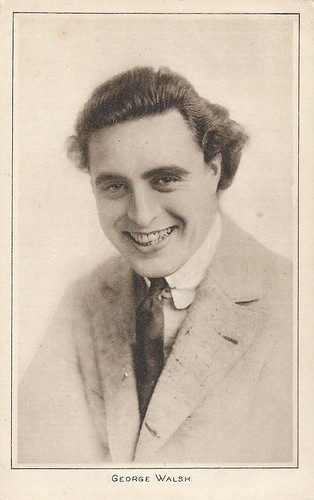
British postcard in the "Pictures" Portrait Gallery by Pictures Ltd., London, no. 113.
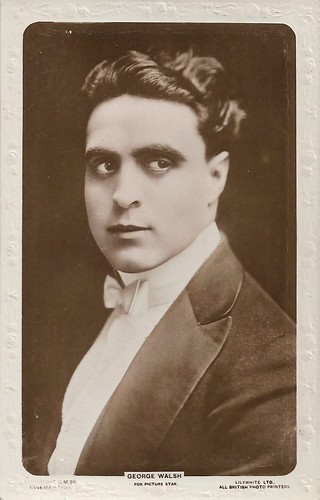
British postcard in the Cinema Stars series by Lilywhite Ltd., no. G.M. 28. Photo: Fox.
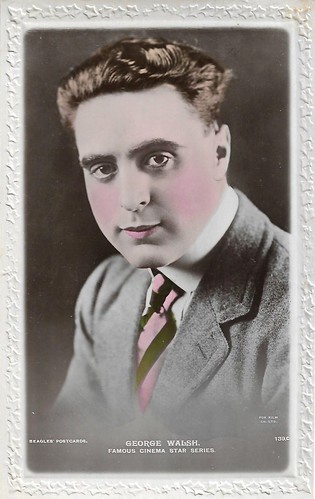
British postcard in the Famous Cinema Stars series by Beagles' Postcards, no. 139.c. Photo: Fox Film.
Sources: Wikipedia (English and German) and .

British postcard in the Cinema Stars series by Lilywhite Ltd., no. CM 411 C. Photo: Fox.

British postcard in the Cinema Stars series by Lilywhite Ltd., no. G.M. 26. Photo: Fox.
A fierce rival to Douglas Fairbanks as a daredevil
George Frederick Walsh was born in New York in 1889 to Catholic parents of Irish descent. He was the middle child of three siblings and his older brother was the later film director, Raoul Walsh. In 1911, he graduated from the High School of Commerce, where he excelled in sports such as baseball and swimming. Later, he also attended the Fordham and Georgetown University.
He followed his brother Raoul to Hollywood, where he made his first films in 1915, including a bit part in D.W. Griffith's controversial epic The Birth of a Nation (1915). Various bit parts followed, until a small role in The Fencing Master (Raoul Walsh, 1915) proved he was capable. Griffith gave him a bigger part as the bridegroom at the wedding of Kana in Intolerance (D.W. Griffith, 1916).
In the following years, the dark-haired, handsome Walsh established himself as a popular leading actor, both in comedies and in adventure films. In 1919 he also directed The Seventh Person with himself in the lead role, but it remained his only film direction.
At the Fox Film Studios between ca. 1916 and 1920, Walsh starred in a large series of fast-paced comedies highlighted by athletic stunt work, by which he became a fierce rival to Douglas Fairbanks as a daredevil, who combined stunts with comic relief. Walsh's good looks made him a heartthrob in the Francis X. Bushman-Wallace Reid tradition. Most of Walsh's successful films at Fox were later destroyed by a fire at Fox in 1937 and thus have disappeared today. Many of these were directed by Walsh' brother Raoul.
In 1920 Walsh had a conflict with Fox about his salary. He turned down a renewal of his Fox contract in 1921 which would have raised his salary from $1500 to $2000 a week in 1921. He felt he deserved more as his pictures always showed a profit while the films of Pearl White, who was making $4000 per week, were financial losers for the studio. He left the studio.

French postcard in the Les Vedettes du Cinéma series by Editions Filma, bo. 30. Photo: Fox-Film.

French postcard in the Les Vedettes de Cinéma series by A.N., Paris, no. 7. Photo: Universal Film Manufactoring Co. George Walsh in With Stanley in Africa (William James Craft, Edward A. Kull, 1922).

British postcard. Photo: Fox.
Unceremoniously replaced
After two years of ups and downs, George Walsh got a contract at Goldwyn Pictures. This single-picture deal Vanity Fair (Hugo Ballin, 1923) led to a long contract and a quick shift from supporting characters to leads. He got his confirmation as Goldwyn star, when Walsh was directed by Ernst Lubitsch as the partner of Mary Pickford in Rosita (Ernst Lubitsch, 1923). As the charming Don Diego, he defends Pickford's rebellious Rosita but soon ends up in prison himself, destined to be hanged. The perfidious King (Holbrook Blinn) arranges a mock marriage before Diego will be hanged, but in the end, the Queen (Irene Rich) saves the situation and Diego's life.
Even more spectacular was Walsh selection by scriptwriter June Mathis for the title role in the super production Ben-Hur, produced by Goldwyn. Walsh had already shot the film halfway with director Charles Brabin in Italy - despite a wide range of problems - when Spring 1924 Goldwyn merged with Metro (the future MGM). The new management unceremoniously replaced Brabin by Fred Niblo and Walsh by rising star Ramon Novarro .
Walsh was not told and discovered it while still in Europe when co-star Francis X. Bushman read it to him from a newspaper headline. George was soon on his way back to the United States. The newly formed MGM did little to combat rumours he had not been up to standard. Until the end of his life, the losing of the role of Ben-Hur was a sensitive subject of discussion for Walsh.
After that, Walsh continued acting but at the independent company Chadwick Pictures and the even more low budget company Excellent Pictures. It was not until 1932 when he started to do his first talking picture: Me and My Pal (Raoul Walsh, 1932) alongside Spencer Tracy and Joan Bennett. Walsh played a sleazy mobster who eyes a naive girl, but her sister (Bennett) and her friend, a cop (Tracy), save her from his clutches. Walsh continued to play supporting parts and bit parts until 1936. After about 80 films, Walsh retired in 1936. His retirement was triggered by the fact he was approaching fifty and was no longer in good shape.
George Walsh love thoroughbred horses and managed the numerous horses of his brother, who were bred and raced on racecourses. This had also been his occupation between silents and talkies. Walsh was married to the actress Seena Owen (1894-1966) from 1916 to 1924, the marriage was divorced. In 1981, seven months after the death of his brother Raoul, George Walsh died of pneumonia in Pomona, California, at the age of 92 years. He was buried at the San Gabriel Cemetery, Los Angeles.

British postcard in the "Pictures" Portrait Gallery by Pictures Ltd., London, no. 113.

British postcard in the Cinema Stars series by Lilywhite Ltd., no. G.M. 28. Photo: Fox.

British postcard in the Famous Cinema Stars series by Beagles' Postcards, no. 139.c. Photo: Fox Film.
Sources: Wikipedia (English and German) and .
Published on June 01, 2019 22:00
Paul van Yperen's Blog
- Paul van Yperen's profile
- 13 followers
Paul van Yperen isn't a Goodreads Author
(yet),
but they
do have a blog,
so here are some recent posts imported from
their feed.



